Public Pier — No Fishing License Required
The term Long Beach is not a misnomer, for here is a beach of hard white sand as level as a floor extending many miles each way. This beach is a perfect natural race course, and during the season spanking teams from the city can always be seen dashing over this superb drive-way. There is a long pleasure wharf.
—Walter Lindley and J.P. Widney, California of the South, 1896
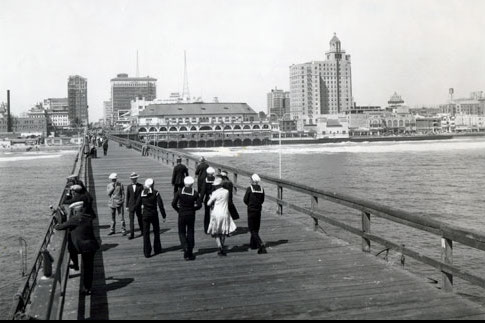
My collection of old pier photos includes a picture taken near downtown Long Beach back in the 1920s. The view looks shoreward from the end of the Pine Avenue Pier and in the foreground a group of sailors, and one young lady, strolls toward the beach. Off in the distance is a long, wide beach, and just beyond the beach are several early-day skyscrapers (or at least large office buildings). It is a picture typical of many beachfront towns.
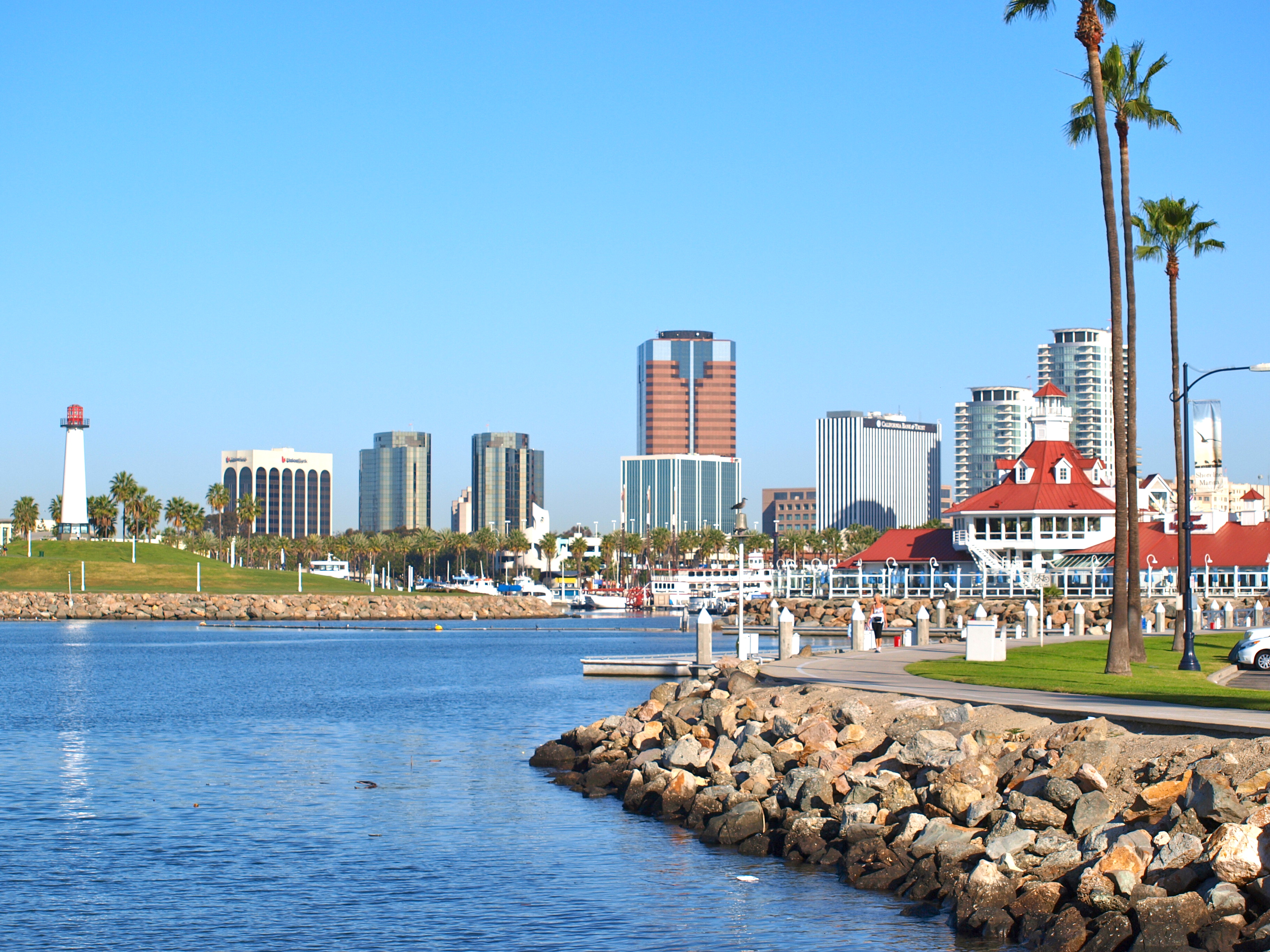
Today, a large marina, a shopping complex, and an aquatic park have replaced what once was water and pier. A true and important piece of Long Beach history seems forgotten. However for the angler, all is not lost. The area is also home to five small piers that jut out from the shoreline surrounding the park. Unfortunately, because of their small size, the piers themselves offer little in the way of facilities; and there are limited parking spaces. Nevertheless, the piers themselves offer an easily accessible fishing spot and attract a steady clientele of regulars from the area. They also offer one of the best platforms from which to view the majestic Queen Mary—once one of the world’s greatest ships.
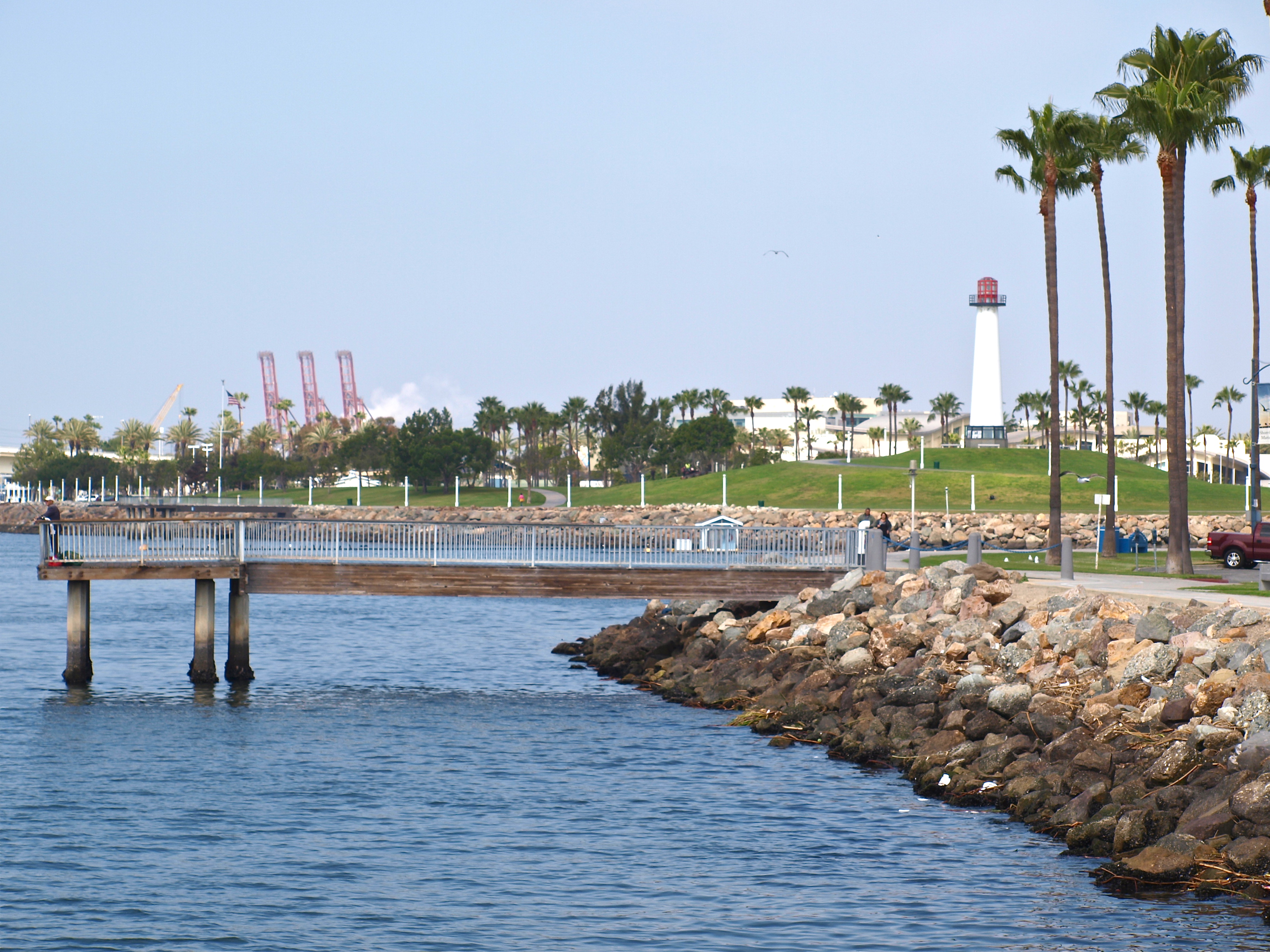
Environment. Each of the five piers sits in Queensway Bay. The three southernmost piers sit on the outer edge of the breakwater that protects the Downtown Long Beach Marina—just out past the Shoreline Village shopping complex (and they are sometimes called the Shoreline Village Piers). The two northernmost piers sit on the outer side of the peninsula that protects and forms the waters for the Shoreline Harbor Marina and the Shoreline Aquatic Park Lagoon. To the north of Queensway Bay is the entrance to the Los Angeles River, to the south and east are the larger areas of San Pedro Bay. The entire area is heavily used by boats of many types and the water itself is less than pristine even though it still contains many fish.
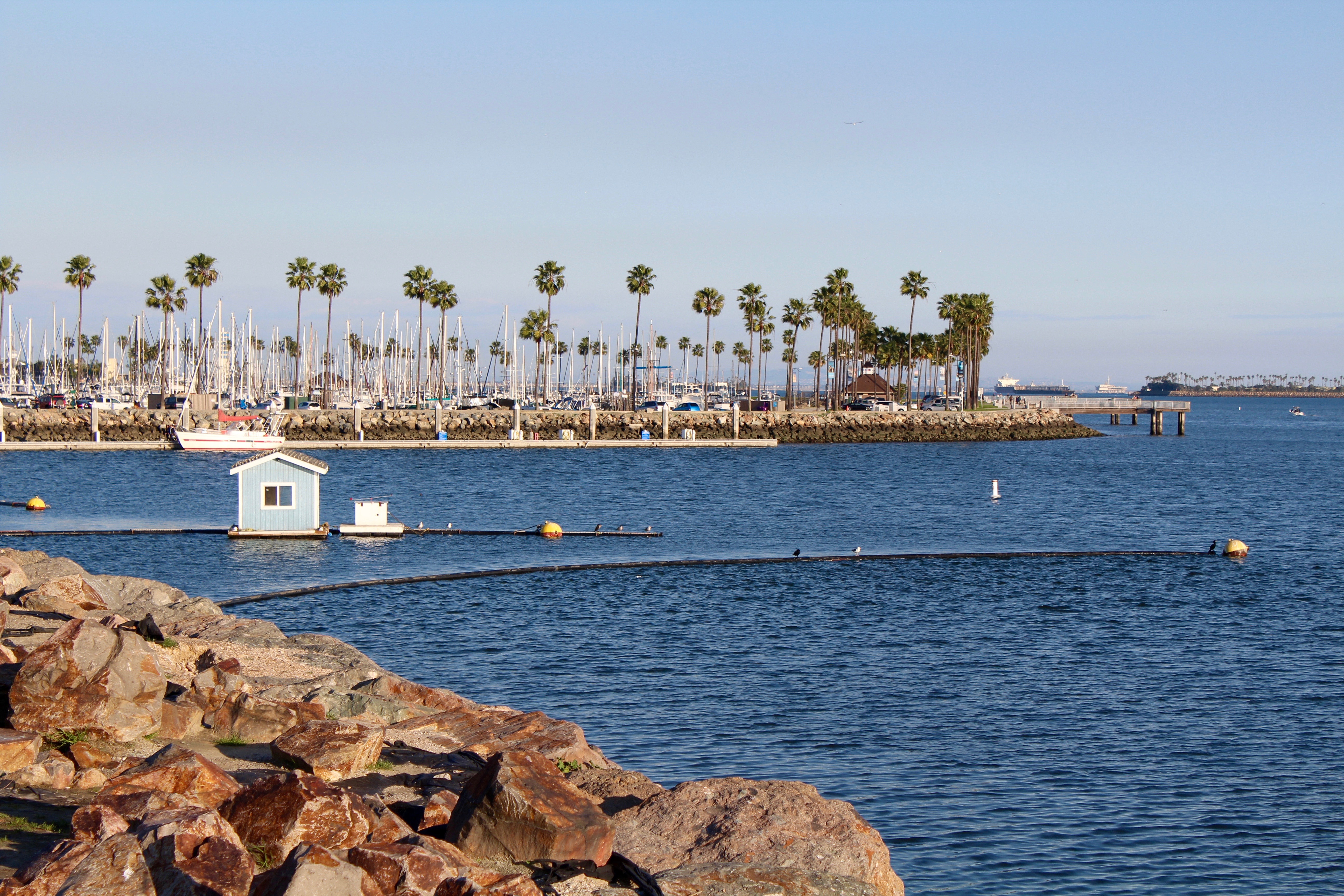
Each of the piers is short, only about sixty feet long, and all were constructed in 1982 along with the Downtown Marina. Sitting as they do on man-made breakwaters, the piers see a typical bay bottom, mud and sand, together with a rocky shoreline area that in many spots is heavily covered with fish attracting mussels.
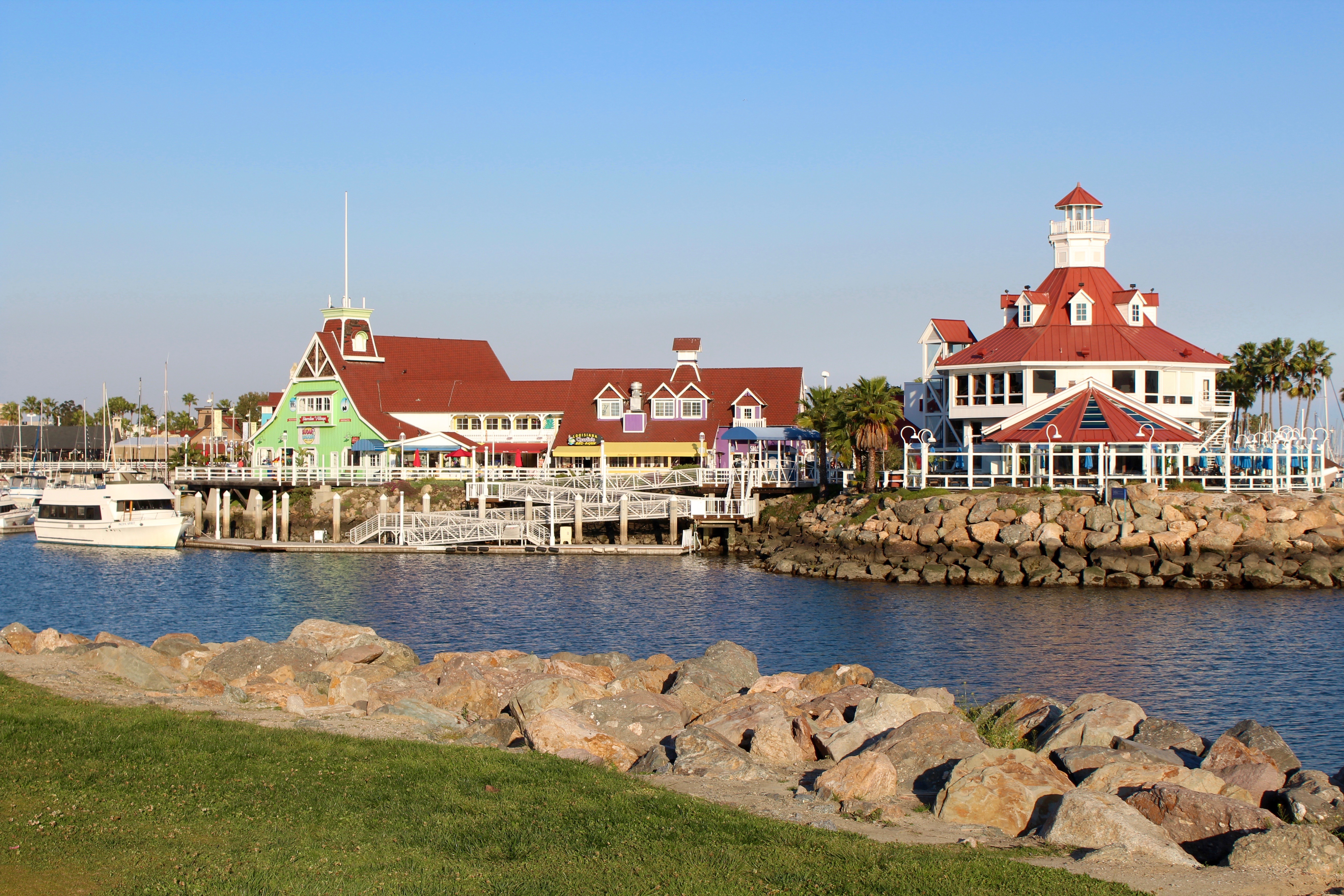
Inshore, along the rocks, anglers typically catch opaleye, several varieties of perch (especially black perch aka buttermouth), and a mishmash of other rock-frequenting species including rockfish and sculpin.
Casting out perpendicular to the pier into the waters that parallel the shoreline often yield the best catches including some nice bass, mainly sand bass and spotted bay bass, yellowfin croaker, spotfin croaker, sargo, perch and halibut.
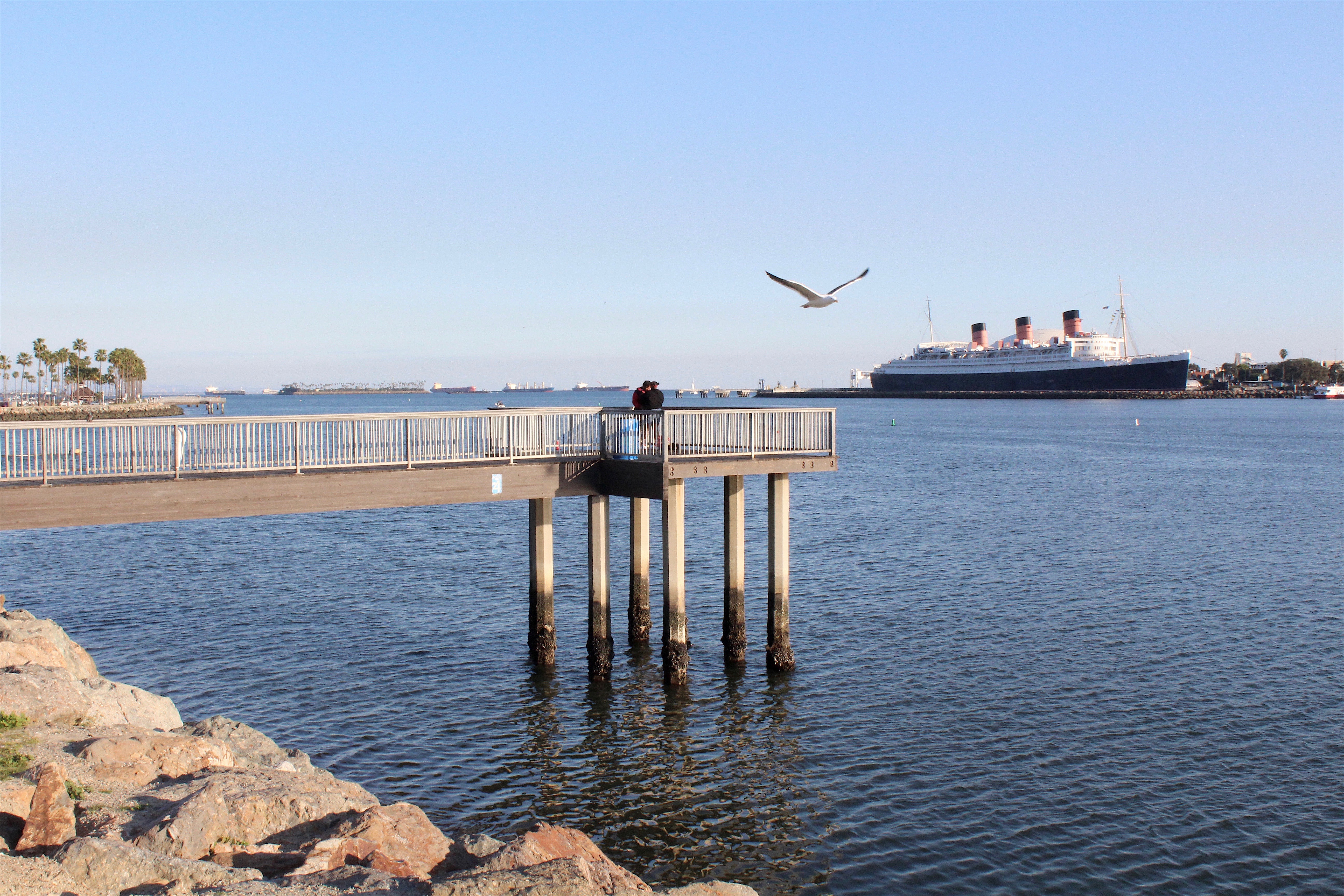
Fishing under and around the pier itself typically yields jacksmelt, small shinerperch, bass and mackerel. Casting out toward the deeper waters, away from the pier, most often yields white croaker (tom cod) and queenfish (herring) but will also offer up some of the larger croakers, sand bass, halibut, diamond turbot and the sharays—sharks and rays.
Reportedly, although I find it a little hard to believe, the northernmost piers also see an occasional catch of freshwater catfish and carp, misplaced species from the Los Angeles River.
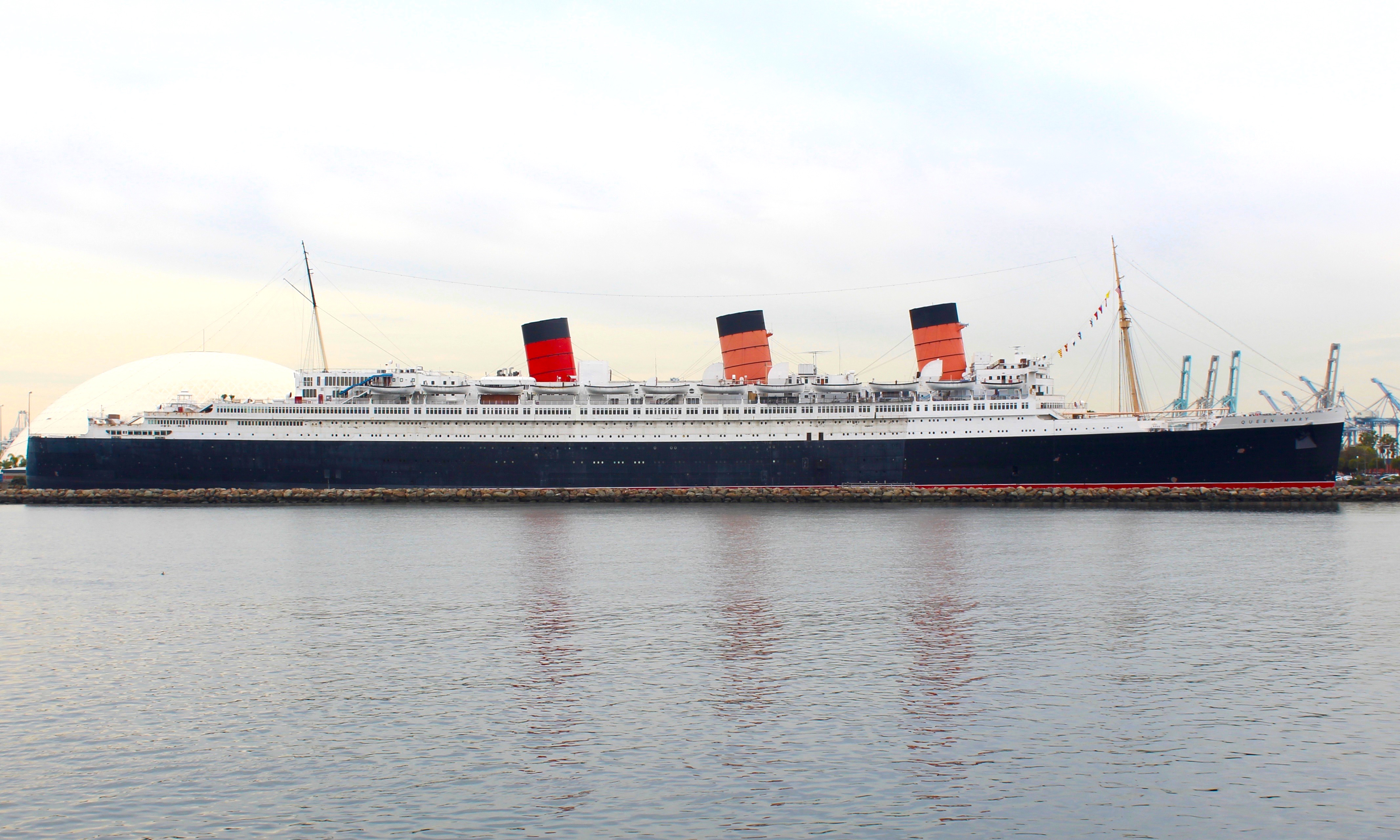
The Queen Mary sits just across the channel from the piers
Fishing Tips. The piers tend to have a Jekyll and Hyde, very good or very bad, nature. Early morning and late evening hours are by far the best times to fish these piers and two different riggings are appropriate here. Use a light set-up around the piers and the inshore rocky areas. Fish a heavier rod for the areas out away from the piers.
Inshore, fish on the bottom, right around the rocks using a high/low leader, small size 6-4 hooks, and mussels or bloodworms for bait. The result will often be bass, seaperch, opaleye, sargo, rockfish, or other interesting rocky-environment-type fish. As example: several years ago I was attending the Fred Hall Fishing Show in Long Beach. Since the show gates didn’t open until noon, I figured I could get a little fishing in during the morning hours. Right at the crack of dawn, and during a good high tide, I headed down to one of the piers. In two hours I managed four kelp rockfish, two blackperch, one cabezon (13”) and a black and yellow rockfish. Not a great catch but some good variety. The rockfish were down in the crevices between the rocks while the perch were about ten feet out from the rocks.
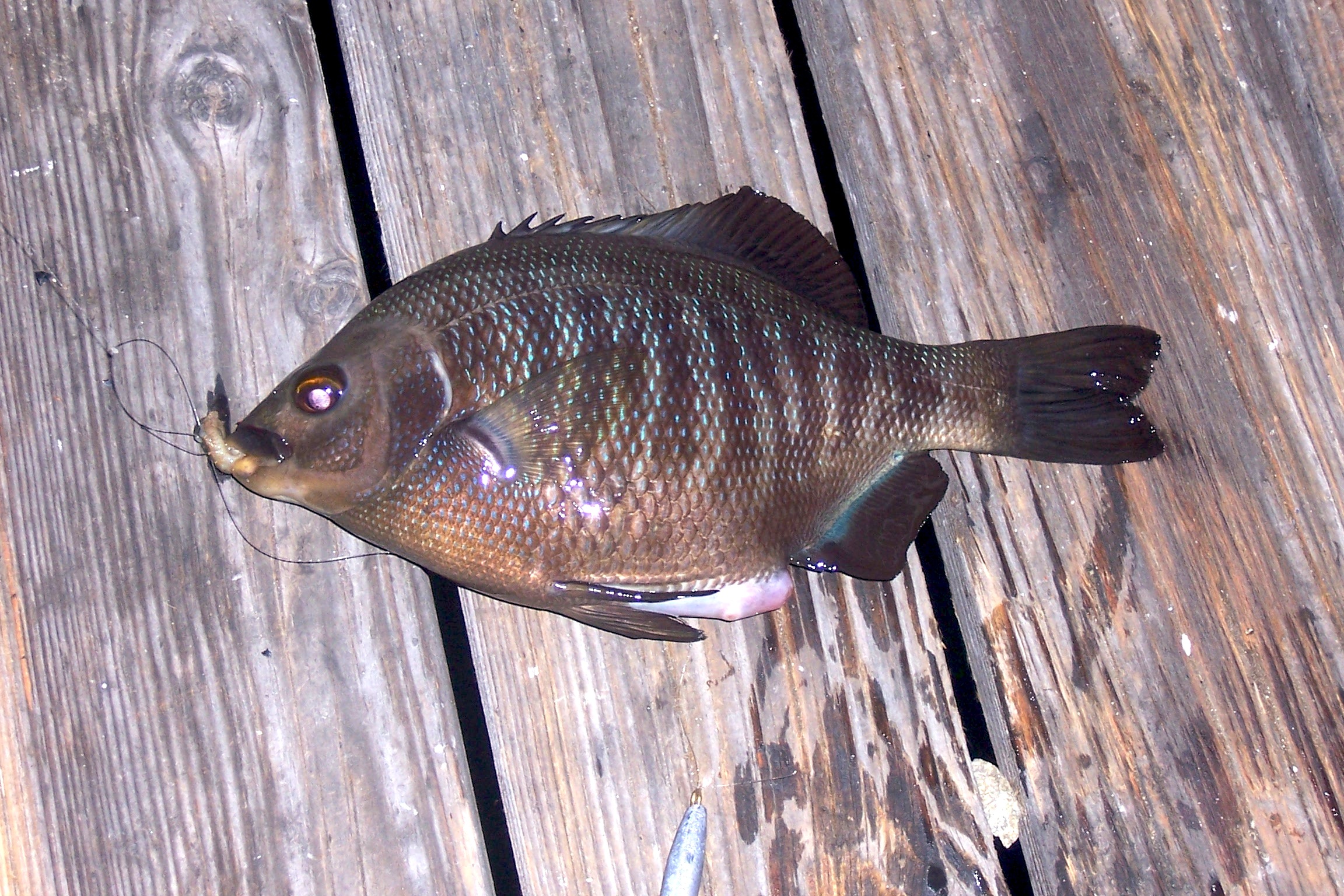
Blackperch
Fish directly under the pier or around the pier with a bait rig (Sabiki or Lucky Lura) with size 8 hooks for jacksmelt, butterfish and sometimes a few queenfish. Usually all that is needed is a slight up and down motion although you may need to sweeten the hooks with a small piece of bait. Cast out into the deeper water out from the pier if the tomcod (white croaker) are making an appearance. Use size 4 hooks baited with small pieces of anchovy for the tommies.
If mackerel show up, switch to a single hook baited with a strip of squid or a piece of mackerel; use a split-shot sinker for weight. You can of course often catch the mackerel with the bait rigs but if the schools are thick, you may be pulling in 3-4 at a time. Eventually the whirling dervish action of the macks will leave your $2-3 leader twisted and tangled and headed for the nearest trash can.
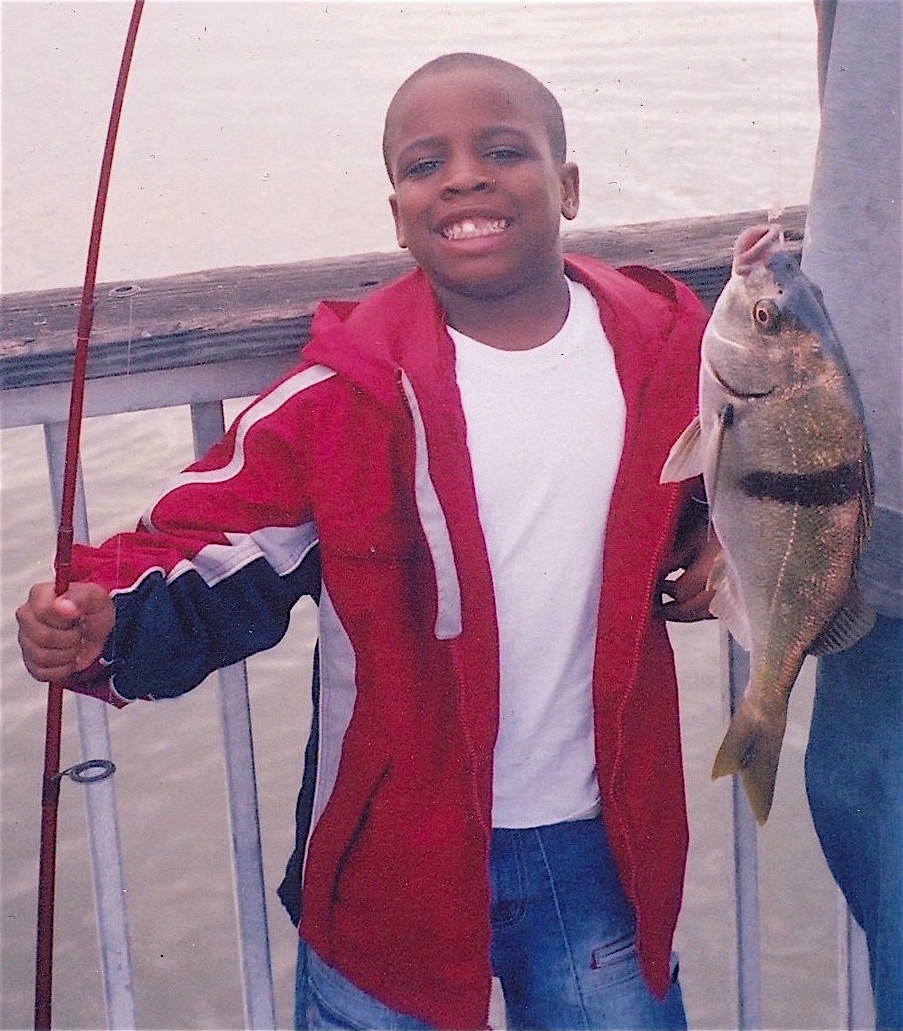
It’s a good pier for sargo
Remember that the early evening hours into the night are generally the best times for spotfin croaker, yellowfin croaker, and sargo. Try fishing on the bottom with a Carolina rigging or a high/low leader using size 6-2 hooks. Best baits are ghost shrimp (the best), bloodworms, lug worms, or fresh mussels for the croakers and grunts. Sand bass too love the evening hours and will take all of the above-mentioned baits as well as anchovies and artificial lures. Mixed in will be a variety of other fish including turbot, sole, blackperch, and a few sharks and rays.
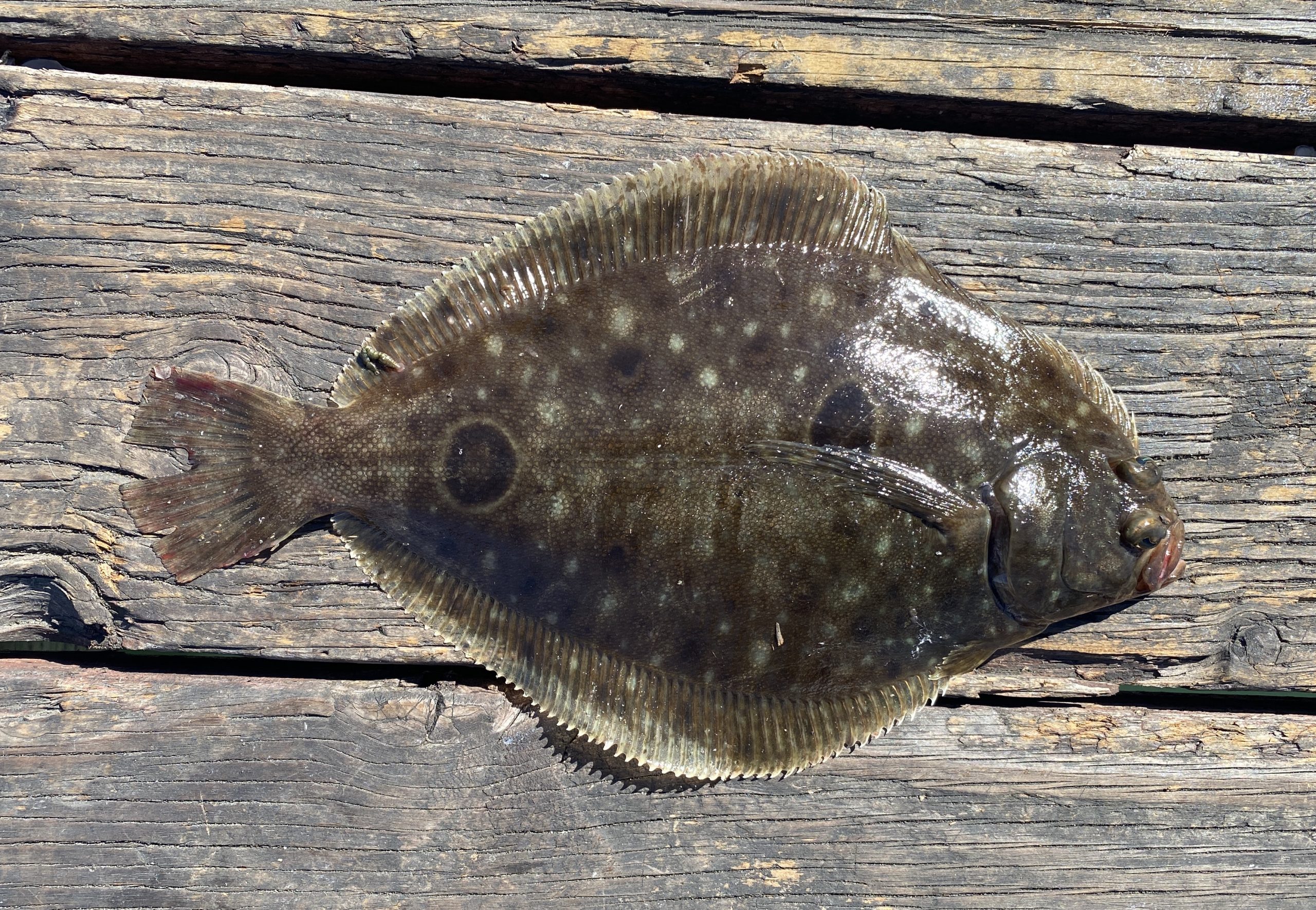
A right-eyed fantail sole (and fantails can be right or left-eyed). Taken by Sal (Salvador) Mercado in April 2024.
Halibut are primarily taken during the daylight hours and love a lively bait (small smelt, queenfish, shinerperch, etc.) but will also hit plastics (i.e. Fish Traps, Big Hammers, and Blams).
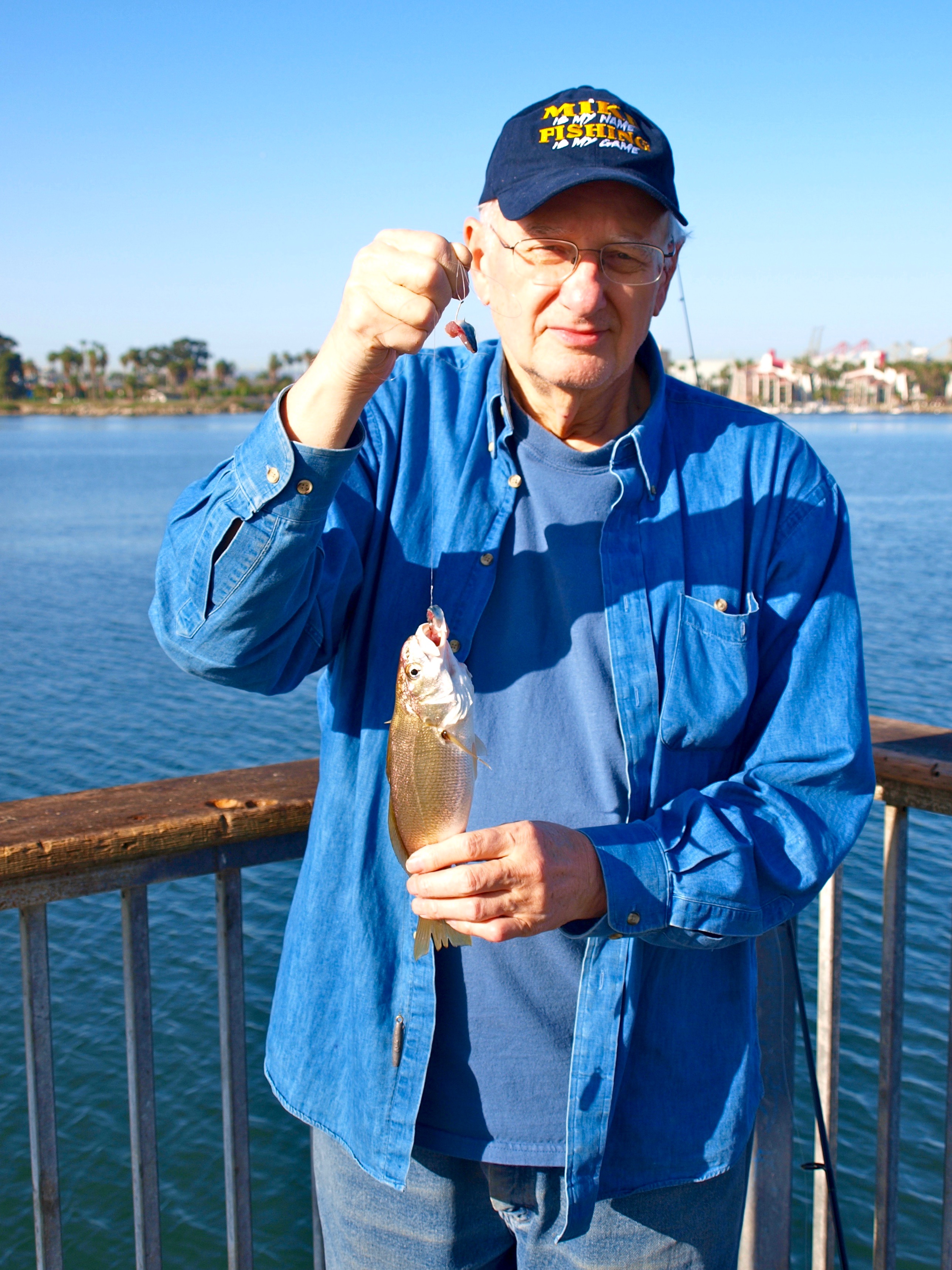
My fishing buddy Mike Granat and a white croaker aka tomcod; they are the number one fish caught at the piers
Some of the locals began calling the pier “Blam Central” in 2007-2008 due to the success of “Blam” lures those years. A Halloween-colored (green and orange) Blam produced numerous legal-size halibut including a 26-pound fish in October of 2007 by “Cedric.” And though the lure has produced a number of big bass, primarily sand bass, the most unusual fish was a 9-pound striped bass that was taken on an identical Halloween-colored Blam the same month as the big halibut. Don’t know what the striper was doing in the southland. The key, according to locals, is to fish the sides of the piers and fish while it’s dark (morning or evening). Unfortunately, it’s getting hard to find the Blam lures.
As far as the sharks and rays, several types, fish on the bottom, away from the pier. Typical bait for these is squid or mackerel; be sure to use heavier rigging and have a hoop net to bring the big girls (the big ‘uns are usually females) up onto the pier.
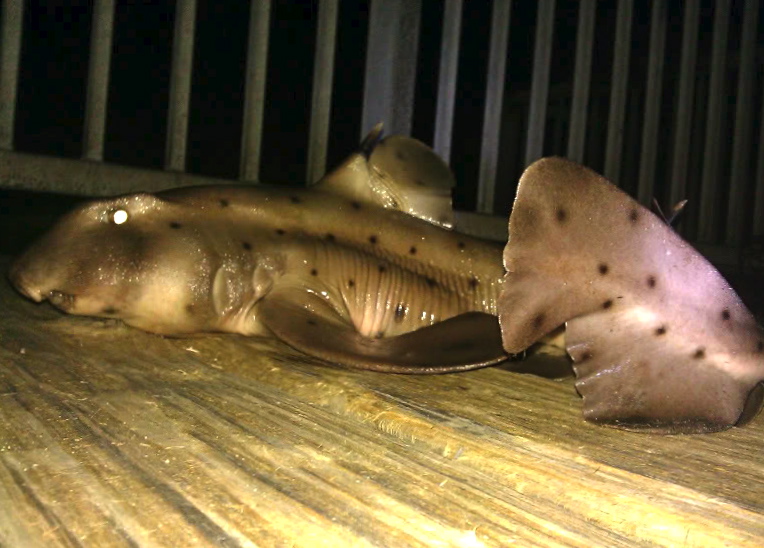
Horn Shark caught by Mr. Woodstream in 2012
One final note is the issue of angler safety. Given that fishing is often best at night, it‘s wise to be in a group. It’s a beautiful area during the day but can be less hospitable at night.
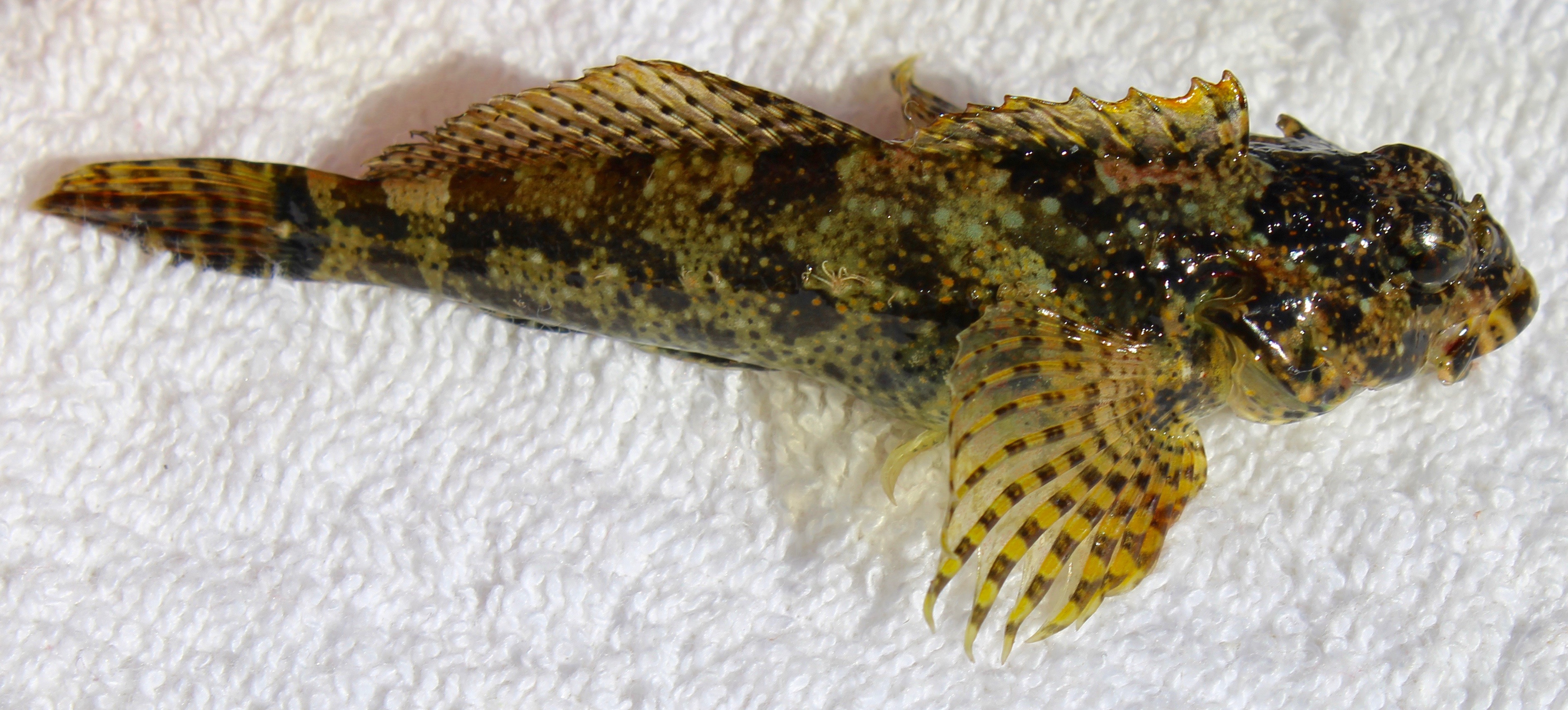
Mystery sculpin sometimes grabs bait intended for larger fish
The Pier Rats Speak
Date: June 20, 2008; To: Pier Fishing In California Message Board; From: Long Beach Pier King; Subject: Shoreline Village early morning report
What a great day for anglers out there today—between the last pier and the rocks. There were about 20+ people out there… seems everyone was fishing for the same thing, perch and sargo. Lots were landed today I caught nine myself in the front area of the pier. A lot of small halis were being caught and released. All the smelts people were catching were too small for anything big to hit it sadly.
Date: November 13, 2009; To: PFIC Message Board; From: Long Beach Pier King; Subject: Shoreline Village last night/today
So we got there at 3am and there was a lot of sargo bites as well as sand bass bites. I landed two sargo, one at around 3 1/2-4 lbs and two bass 1 released. As we walked up we saw a group a guys with some nice keeper bass in their buckets… We used ghost shrimp and bloodworms and it seem that bloodworms is the bait to go with…. Bonito are still running through the area as well as herring. I saw a load of baitfish all around the pier so I’m sure there are some halibuts somewhere within the area but I didn’t see anyone fishing for them today. My advice for anyone who goes out there will be to fish from night- 8/9am.
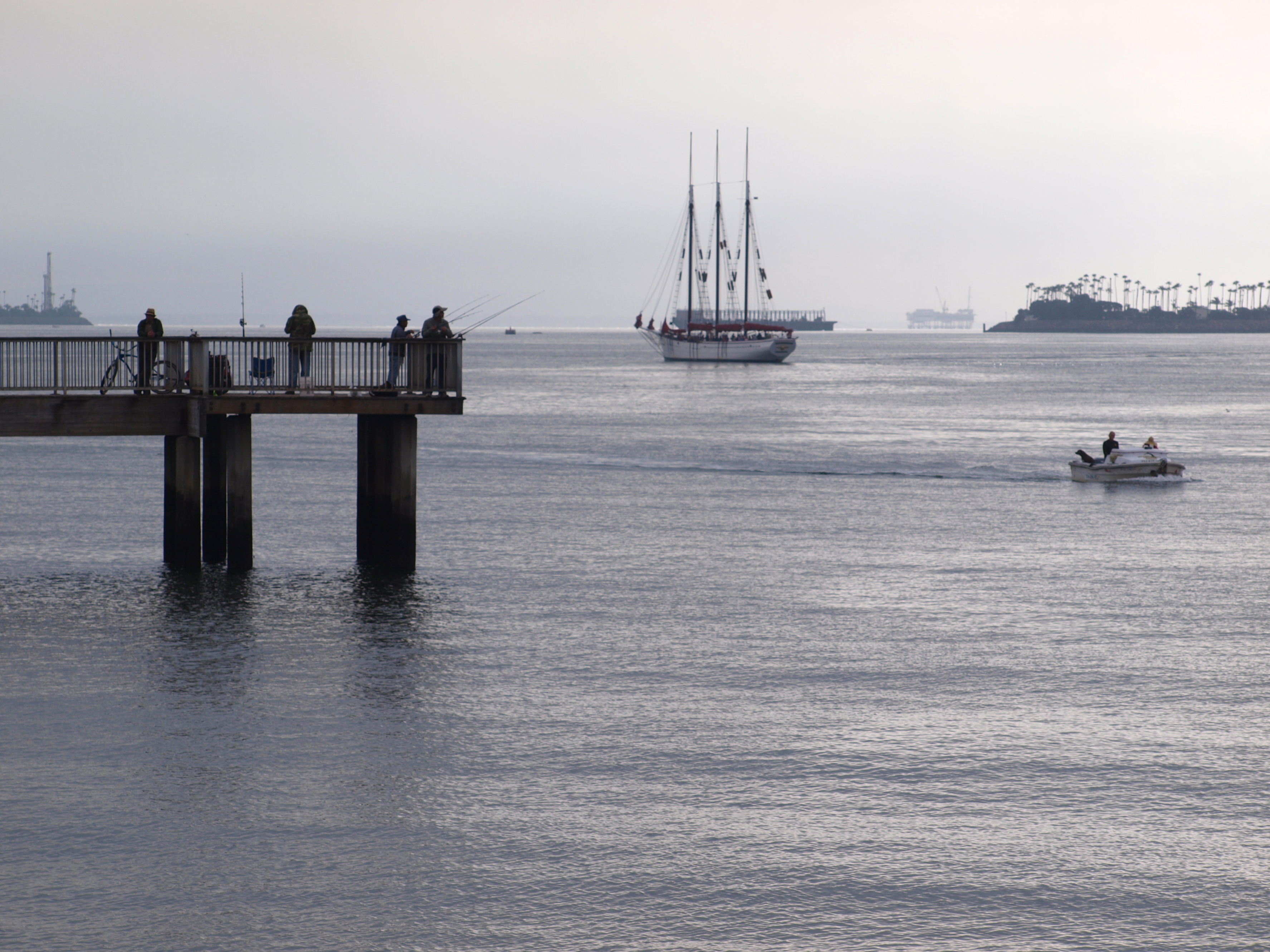
The Birds. I like birds and always enjoy watching the birds at piers as long as they aren’t too obnoxious or over bearing in their attempt to steal bait and/or fish on a line. Sea Gulls and Pelicans seem most aggressive but there are many other birds that show up at piers including herons and egrets. These piers always seem to have birds just hanging around.
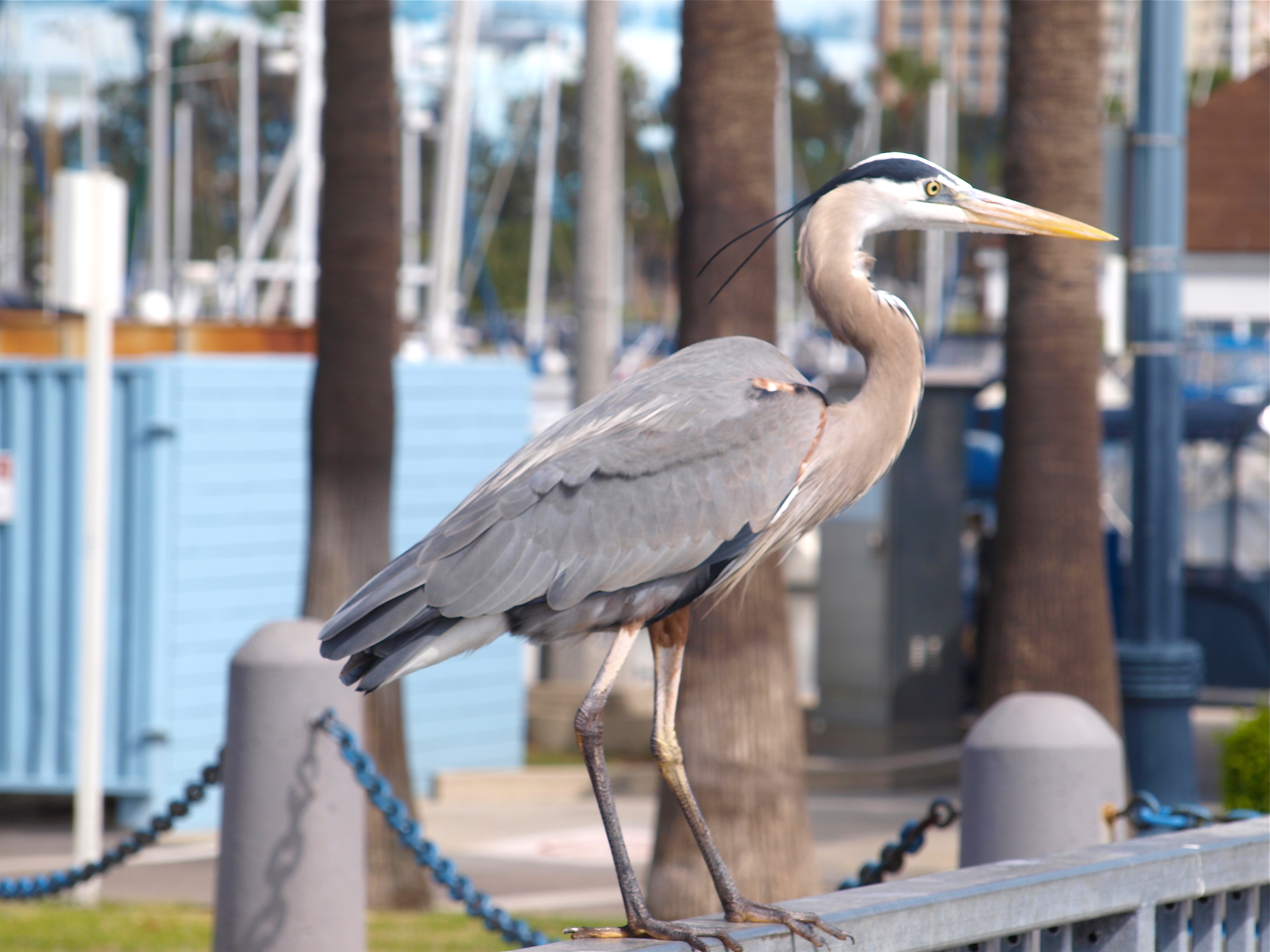
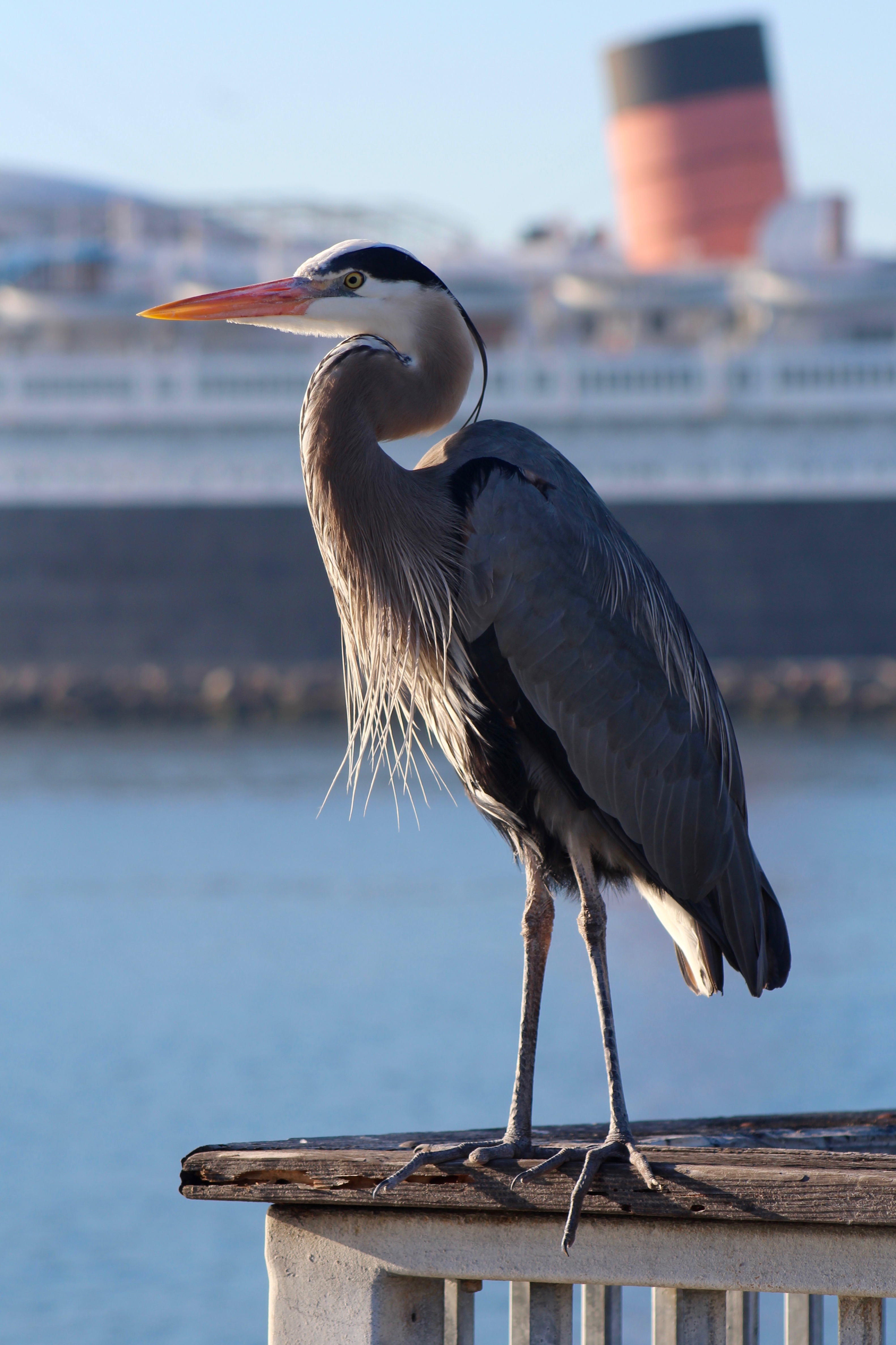
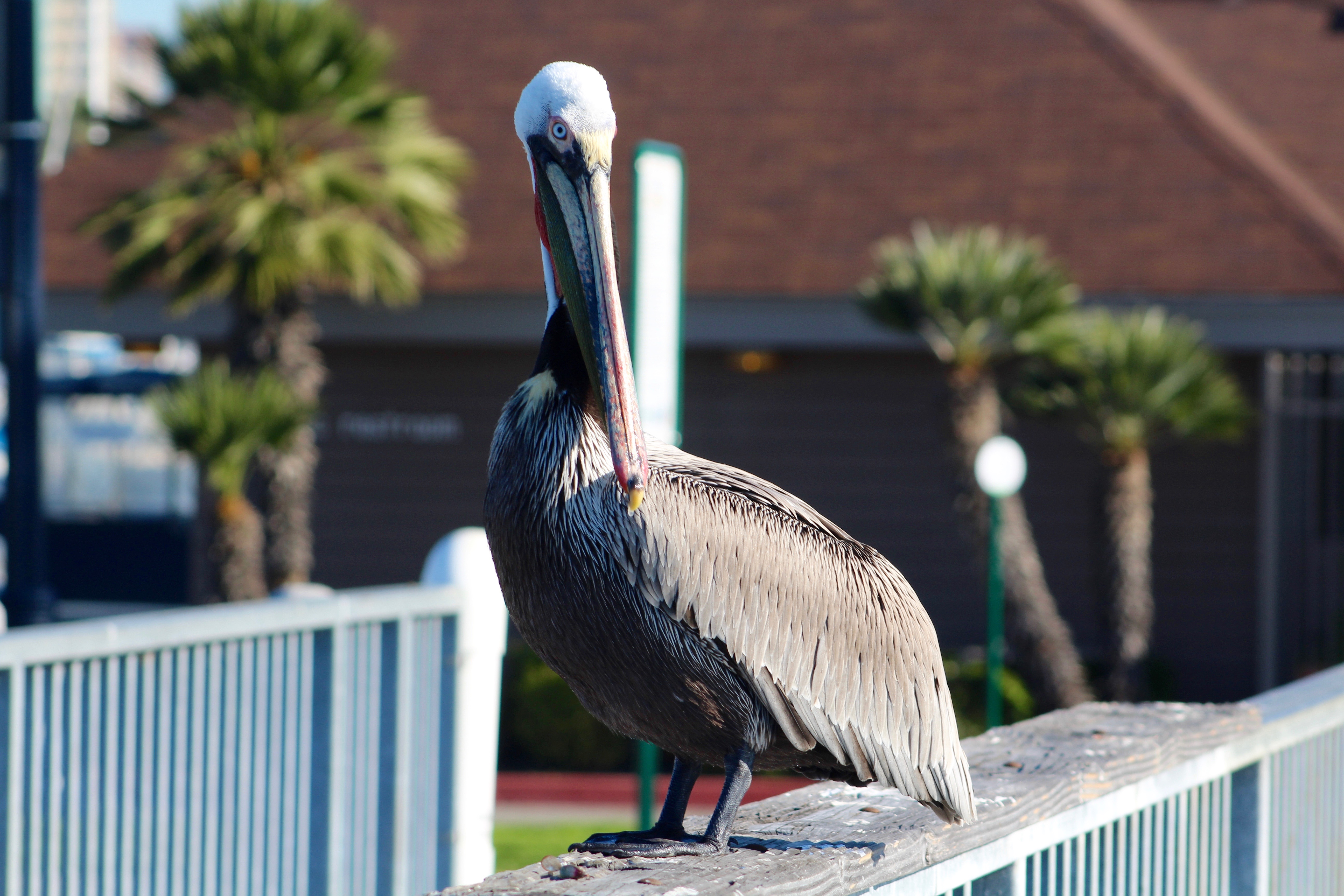
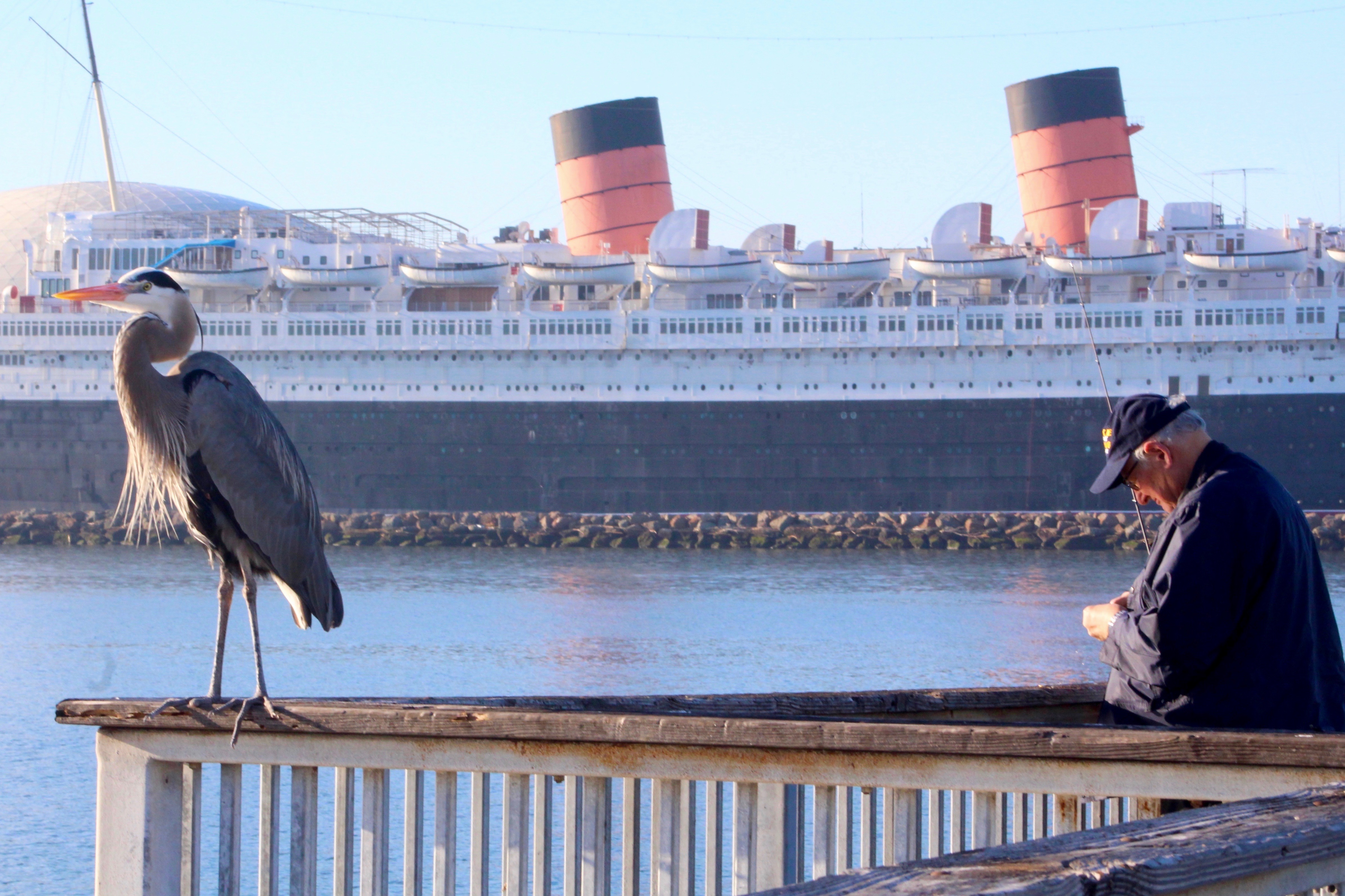
I guess this bird decided to be a buddy to my buddy Mike.
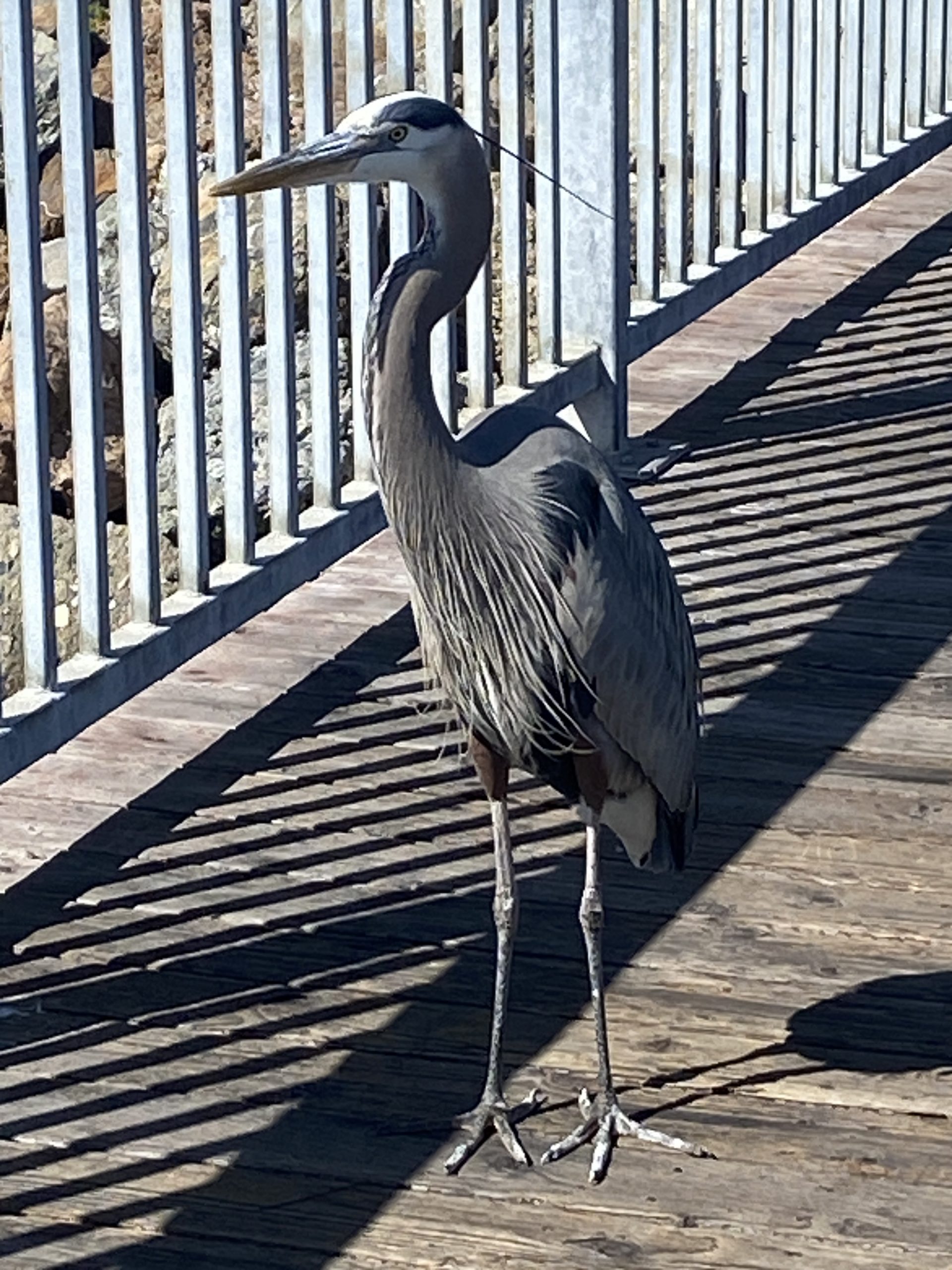
Pier Fishing In California Fish Reports — A few
November 2004— Jason, at Paul’s Bait and Tackle, 803 South Pacific Ave. in San Pedro, reports that anglers are getting some bonito, halibut (both shorts and legals) and sargo at the small finger piers. Use ghost shrimp for the sargo; try live smelt or white Blams for the halibut.
June 2005— Bill, at Paul’s Bait and Tackle, reports continued good action on sargo, yellowfin croaker, and big sand bass while some nice halibut are also being taken. The sargo and croakers are hitting ghost shrimp, the bass strips of squid, the halibut on live bait and 6” “White Blam” Worm Kings. Some small spotted bay bass are also available, usually on the sides of the pier.
September 2005— Lowell, at Paul’s Bait and Tackle, reports excellent action on 1-4 pound sargo using ghost shrimp. One family of four people reported 20 of the good-sized fish. The piers are also seeing some mackerel, white croaker, bass, perch and a few halibut.
June 2006— Joe, at Paul’s Bait and Tackle, reports fairly good action on buttermouth perch (blackperch) and sargo; try ghost shrimp, mussels or lugworms. A few sand bass are also hitting on plastics and cut anchovy. A few halibut are also making an appearance; most fall to live smelt. Casting out from the pier in the evening can yield yellowfin croaker on fresh mussels and lugworms while white croaker will hit on cut anchovies.
July 2006— Bill, at Paul’s Bait and Tackle, reports good numbers of yellowfin croaker, sargo and corbina; for all use ghost shrimp and fish the sides of the pier. Cast out from the ends of the pier for halibut, white croaker, sharks and rays; use plastics for sand bass. He says the first pier, the one almost under the bridge, has been the best pier for corbina and yellowfins, especially at night. Banjo sharks (thornbacks) round out most of the action.
September 2006— Jesse Zambata, at Paul’s Bait and Tackle, says there’s been some good action on leopard sharks and shovelnose sharks (guitarfish) for those seeking them out. Yellowfin croaker, BIG sargo, and sand bass are also hitting good. Use ghost shrimp, lugworms or fresh mussels for the croakers and sargo, cut bait or artificials for the sand bass. White croaker (kingfish/tom cod) are also almost always available to those using cut anchovies. A lot of halibut are also showing up, especially for those using live smelt as bait.
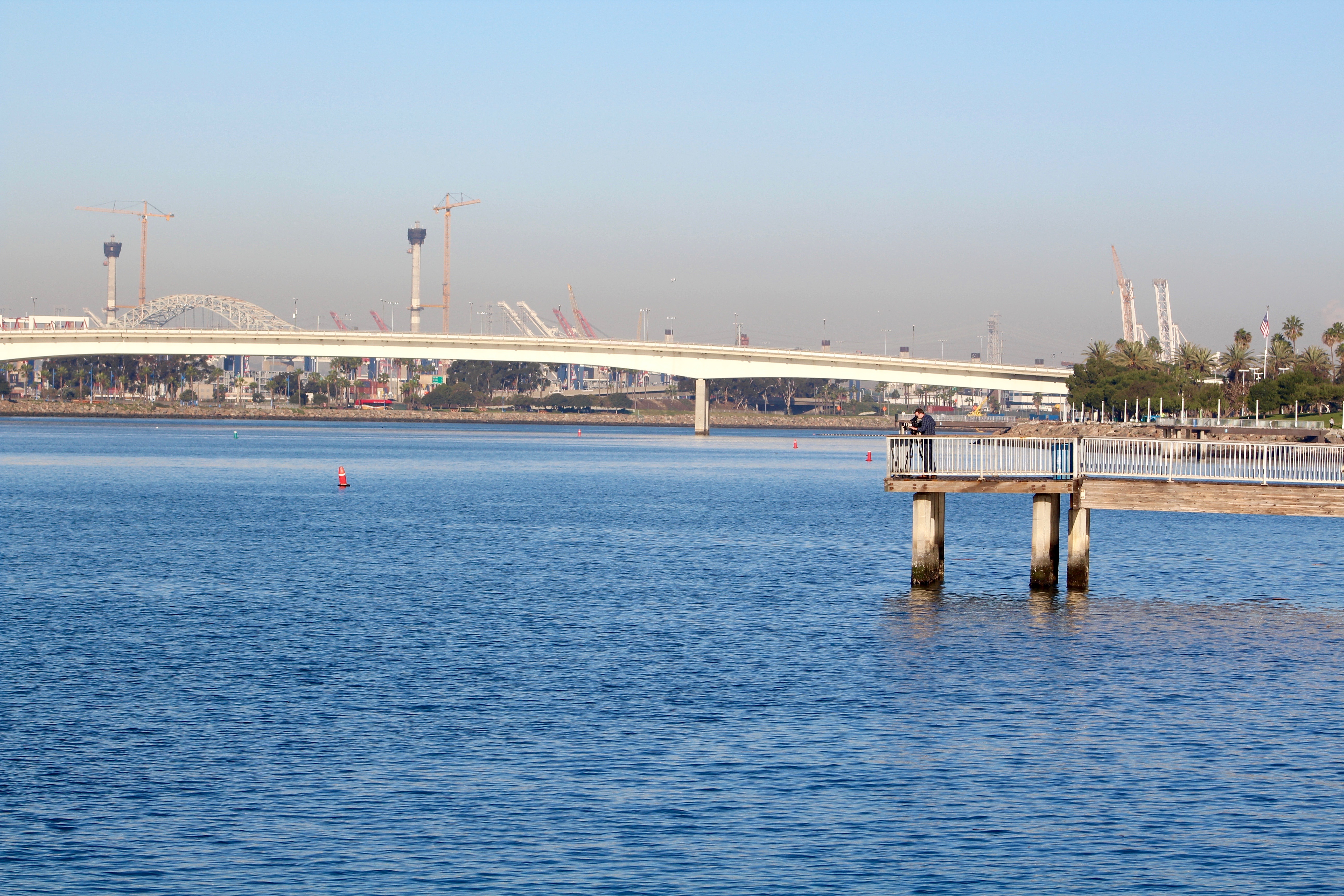
October 2006— Joe, at Paul’s Bait and Tackle, says anglers fishing from the sides of the piers (shallow water) are getting good numbers of sand bass and sargo. He says the sargo are hitting ghost shrimp and lugworms while most sandies are falling to plastics, especially green plastics. He says if you’re getting taps on the ghosties during the retrieve switch to a plastic and it’s probably a sandie. Some corbina and yellowfin croaker are also being taken from the sides of the piers. Casting out from the front of the piers is yielding mackerel, good numbers of keeper halibut, and both leopard sharks and guitarfish (at night).
March 2007— Bill, at Paul’s Bait and Tackle, says anglers continue to take good numbers of buttermouth (black seaperch) and sargo when using ghost shrimp. He says if you’re getting nibbles—but no hits on the retrieve—switch to plastic with maybe a squid trailer. There’s lot of good-sized sand bass around the pier but they’re on a light bite.
August 2007— Bill, at Paul’s Bait and Tackle, said that action is wide open on calicos and BIG halibut. They’re hitting live bait (smelt and ghost shrimp) and a variety of artificials—Krocodiles (blue pattern), white Blams, Holloween and green-speckled Blams (calicos on the orange, sand bass on the green). He says the calicos and halibut are all over that Long Beach area. Other than that it’s the usual smaller fry—buttermouth, smaller croaker and sargo (best at night). All around best bait—ghost shrimp. By the way, he’s been doing a test on Gulp bait. His regulars tell him ghost shrimp out fish the Gulp four to one, lugworms out fish the Gulp two to one.
November 2007— Bill, at Paul’s Bait and Tackle, said it’s “Blam” City at the piers. Regulars have been using Halloween-colored (green and orange) Blam lures to get a steady number of halibut. A 26-pound hallie (caught by Cedric) led the list but many of the fish are keepers. The surprise fish, on the same lure, was a 9-pound striped bass taken by Kevin. He says they are also getting a lot of huge yellowfin croaker and big spotfins on ghost shrimp as well as some calicos and sand bass. The key is to fish the sides and to fish early morning (when it’s dark) or in the evening (when it’s dark). I asked if people used lanterns since there are no lights on the piers but he says most people are now using the Promar lights that fit on your head. Results during the day are totally different.
Special Recommendation. Because of elevated levels of DDT and PCB in tested fish, the Cal OEHHA recommends the following regarding fish caught in Long Beach Harbor. “Anglers should eat no white croaker, and no more than one meal every two weeks of queenfish, black croaker and surfperch.”
Potpourri — Perhaps more than you may want to know about the Long Beach Shoreline Piers
<*}}}}}}}}}>< — I always enjoy visiting aquariums and close to these piers is the best aquarium in southern California—the Aquarium of the Pacific. More than 12,000 fish and assorted other creatures are located in four recreated environments—Baja California, cold-water northern Pacific, tropical coral reefs and SoCal kelp forests. If visiting for a few days don’t miss it. Of course it’s a SoCal attraction so it’s almost always busy; visit early on the weekends (get there at the opening 9 A.M. bell) or mid-afternoon (around 2 P.M.) on weekdays. Visit www.aquariumofpacific.orgfor more information.
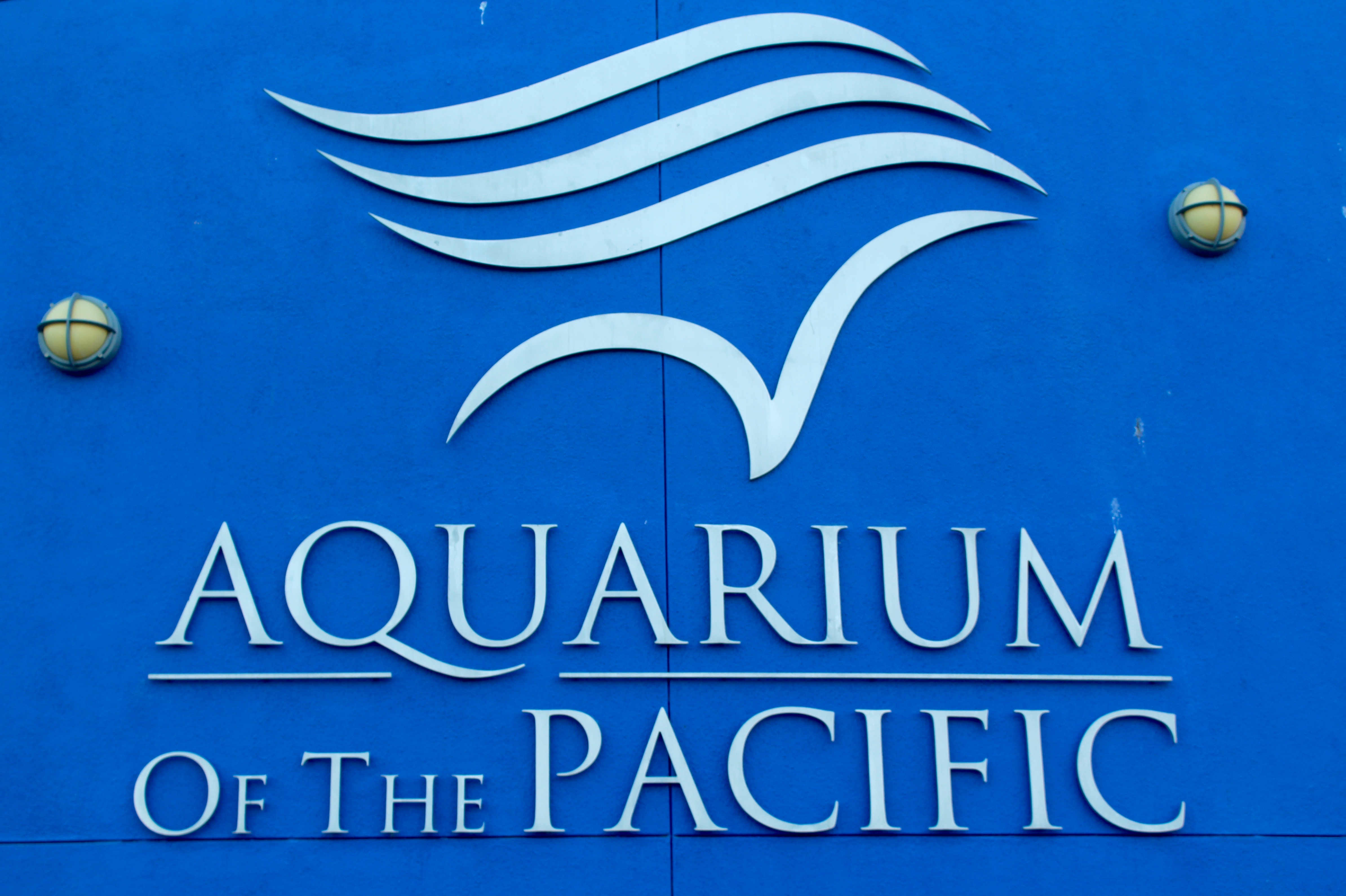
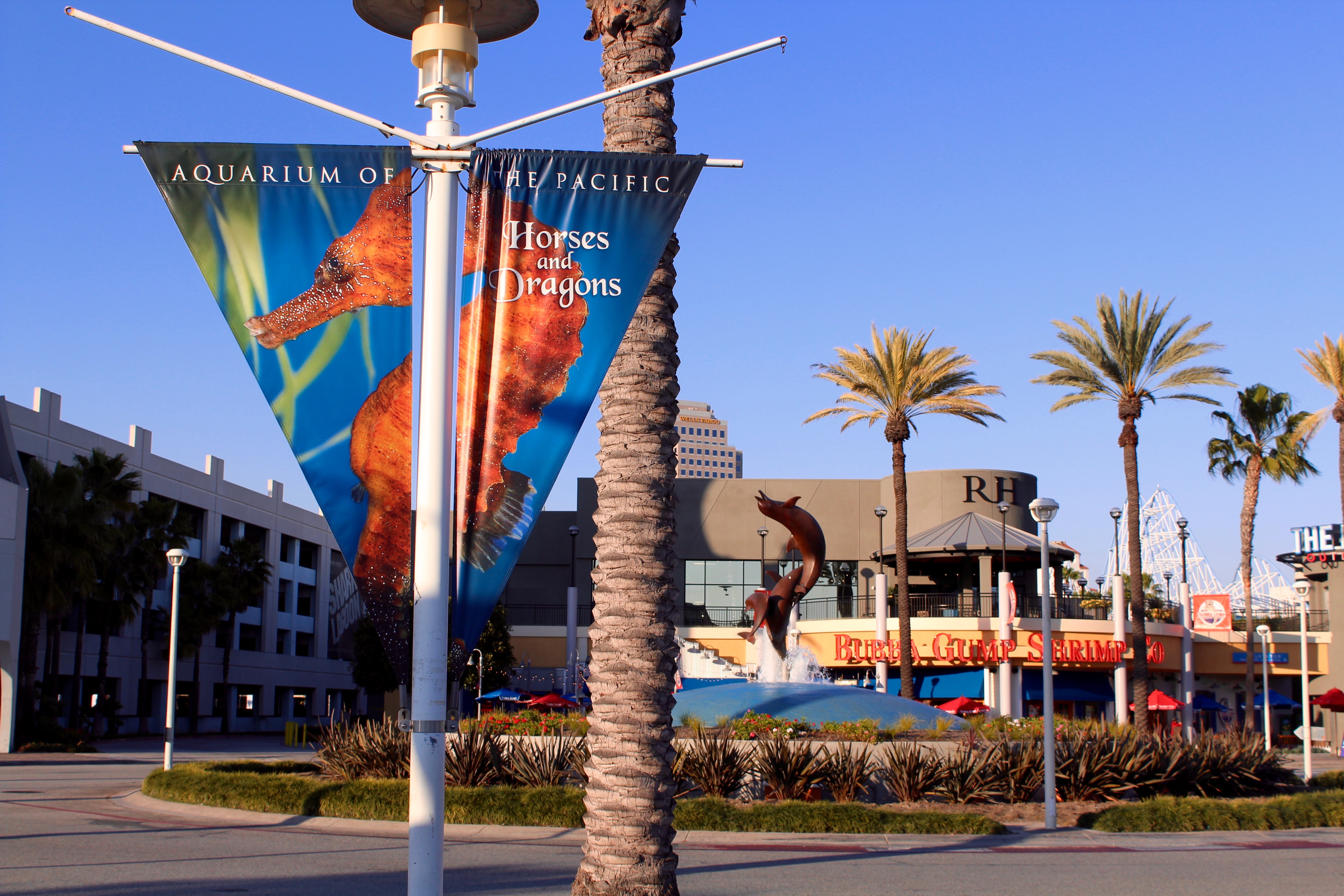
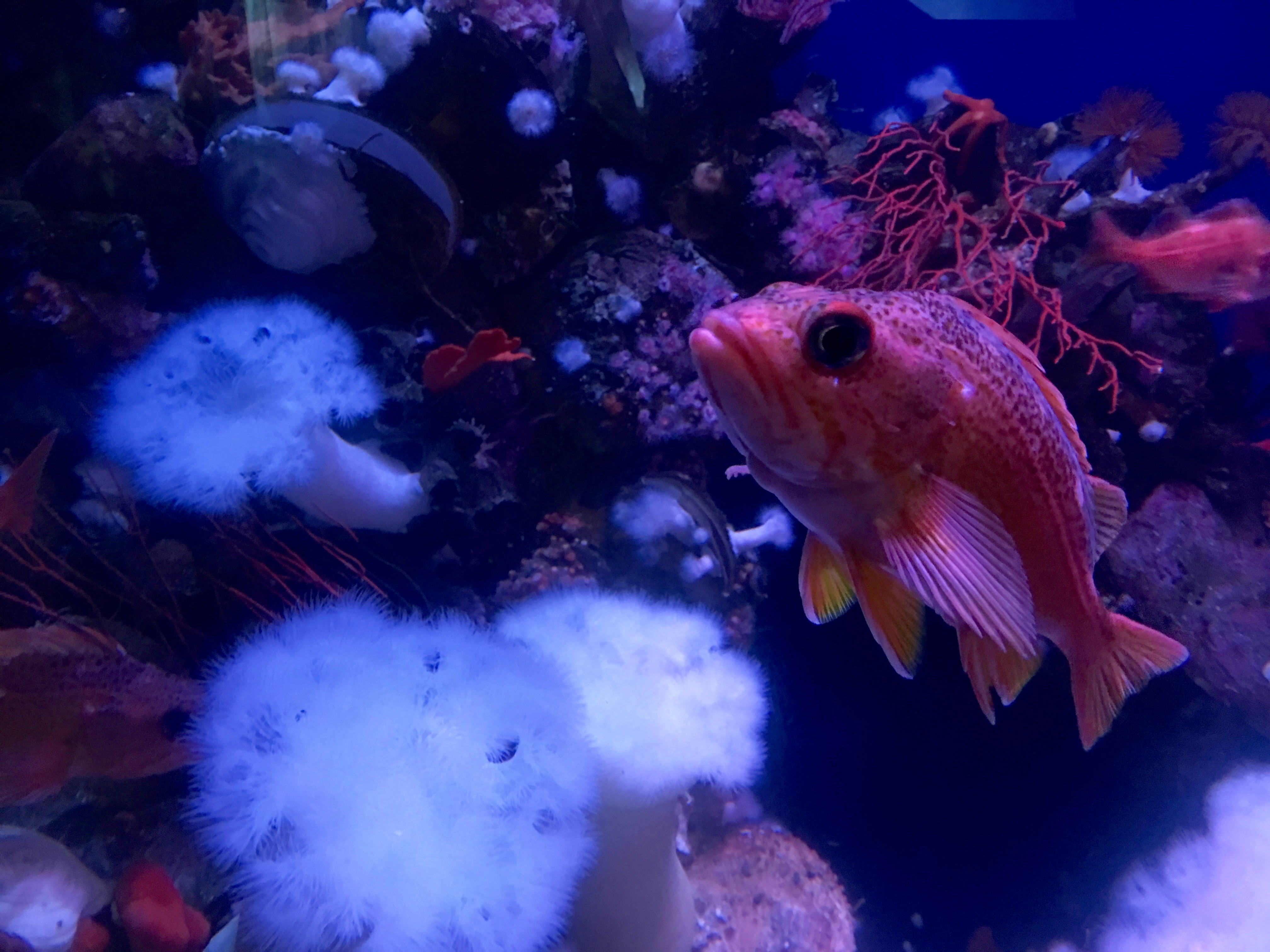
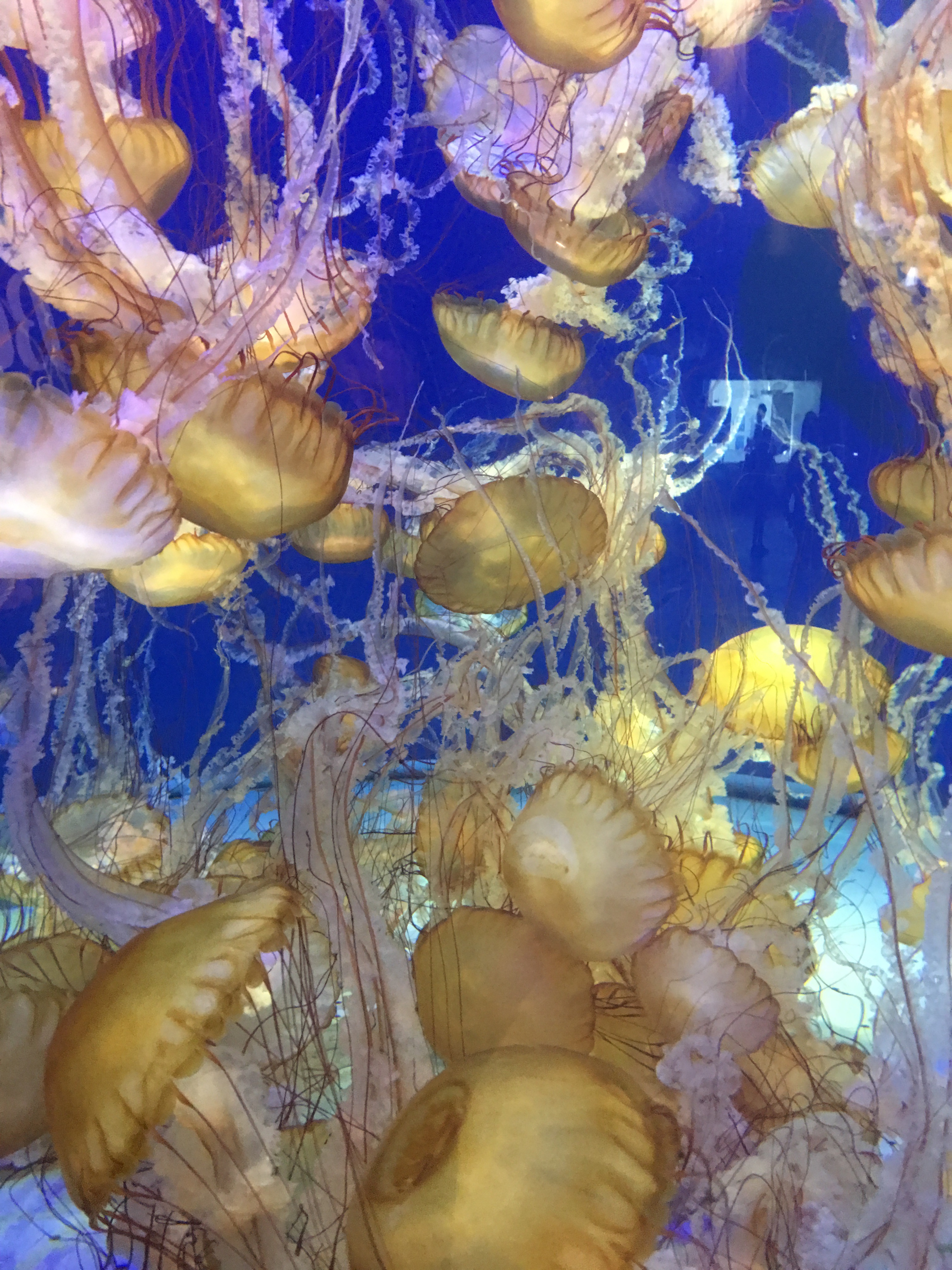
<*}}}}}}}}}>< — CA F&G Bulletin #96 from 1953 states: “Located on the north shore of San Pedro Bay 20 miles south of downtown Los Angeles… On the Long Beach harbor there are unloading docks for market fish and several fish canneries. Over the past 20 years the average landings have been 69,000,000 pounds per year with a peak of 138,000,000 pounds in 1945. The leading species handled have been sardines, yellowfin tuna, skipjack, mackerel, yellowtail, albacore, anchovy, bluefin tuna and abalone. The city has had, throughout the years, several pleasure piers for anglers. At Belmont Shore there is now a modern pier. In 1952 there were 22 party boats and 64 charter boats out of Long Beach. Five fishing barges were anchored offshore.”
<*}}}}}}}}}>< — Although I don’t have many records of the fish from the early day Long Beach piers, a Pacific moonfish (Vomer declivifrons) was recorded as being taken a short ways off the Rainbow Pier on March 18, 1959.
History Note. As mentioned, and although it’s sometimes hard to imagine today, the waterfront area of Long Beach was a fairly typical oceanfront resort at the turn of the century. The Long Beach Land and Water Company had taken over W.E. Wilmore’s failed real estate venue called Wilmore City in the early 1880s. They renamed the area Long Beach, improved the water system, instituted a horse-car line, connected the town with the Wilmington line of the Southern Pacific, built a hotel—and built a pier. Long Beach quickly became a popular destination for those seeking fun and sun in a seaside setting.
The pier built by the water company would be the first of many in the city. It was the Magnolia Avenue Pier, built in 1885 for the princely sum of $4,000. The pier was 700-foot-long, 32-feet-wide and included an underwater light for night fishing. The pier, according to records, quickly proved very popular with the fisherman who caught yellowtail, barracuda and halibut from its deck. A 632-pound jewfish (giant sea bass), caught by William Schilling and his son, was reported from the pier but it’s unclear if the fish was actually caught on the pier or on a boat from the pier.
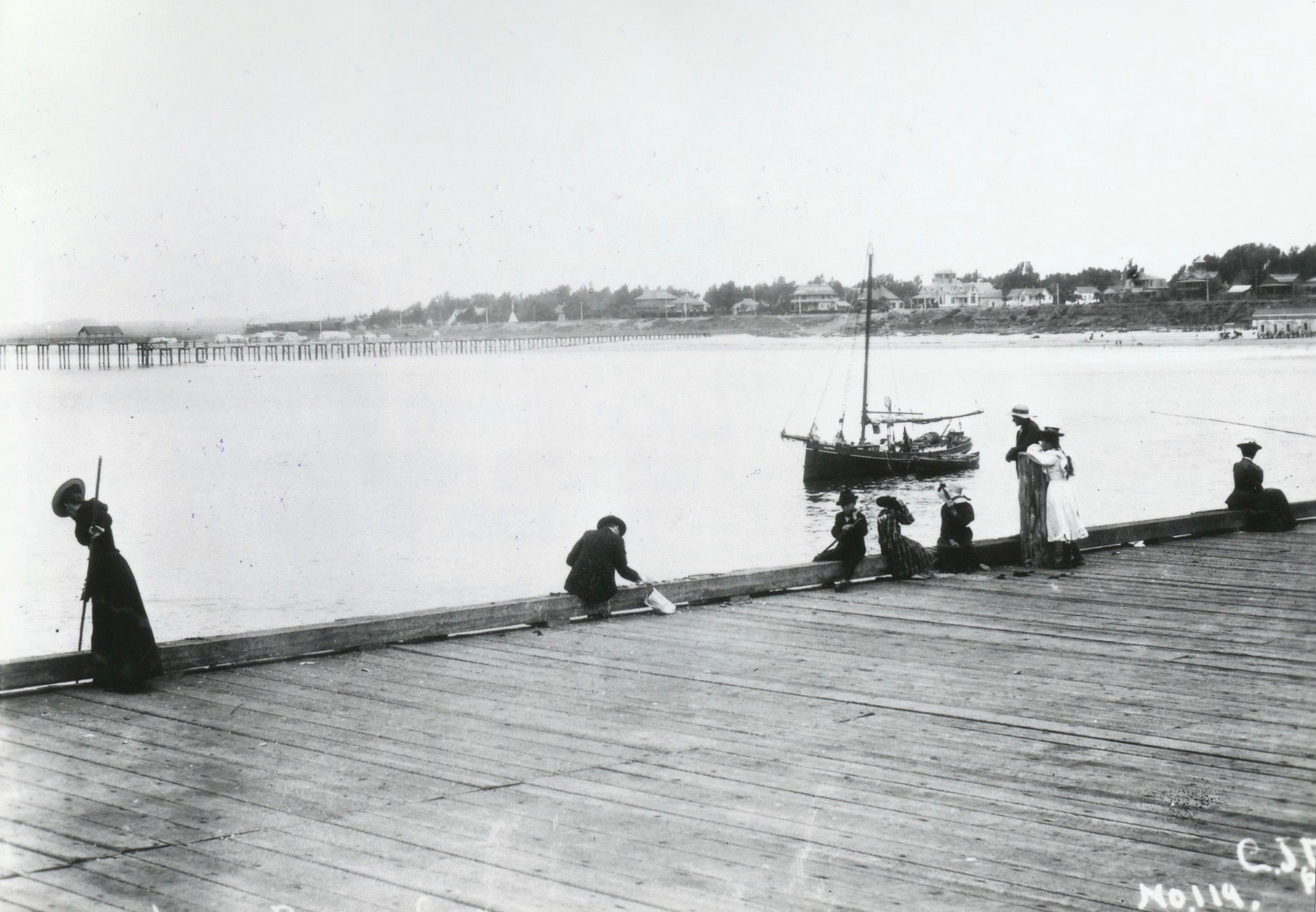
Magnolia Avenue Pier
Unfortunately it began to weaken after only five years of use, was declared unsafe, and the shore end of the pier was removed in 1892. Most of the rest of the pier was destroyed by waves in 1900.
Ironically, in 1951 a new “Magnolia Ave. Pleasure Pier” was built. However, it was simply a 480-foot-long pier/boat launch for small boaters. It was built at a cost of $74, 305. The U.S. Navy acquired the site in 1955 as a landing site and eventually built a pier and seven docks. However, the city of Long Beach reacquired the site (1958-1960) and filled it in by dredging and reclamation between 1960 and 1964.
Next in line was the original Pine Avenue Pier, the first municipally owned pier on the Pacific Coast. The pier was also the first purchase made by the citizens of Long Beach and perhaps prevented citizens from disincorporating the city (since there was a huge argument over taxes and the lack of services which people felt should have been provided by the taxes). The pier seemed to unite the people and provide a reason for the city government to continue. The Long Beach Eye editorial proclaimed, “we are for the people and the people want a wharf,” and the $15,000 bond issue for the pier passed easily.
The 1,700-foot-long pier opened on May 27,1893, with a celebration that included a barbecue, speeches, and the running of a special midnight tourist train by the Southern Pacific Railroad. Several thousand people visited that first day including many anglers (whose catch was not recorded). The Los Angeles Times reported the event the next day, “Long Beach Wharf—The Only Wharf Free From Taint of Monopoly” (which reflected the fights and the political dirty deeds common among the railroads and politicians during those days). Evidently the only disappointment was the failure of the steamer Rosalieto provide free hourly excursions (because of an accident).
The new pier drew a considerable number of tourists as it provided a home for vendors and entertainment such as a merry-go-round. Buildings sprung up around the pier including a beautiful pavilion that was built at the foot of the pier in 1897. The pavilion was designed for concerts and nightly dances (although dances were limited to Tuesday and Saturday nights after local ministers complained that public money was being used for purposes which they considered morally offensive). Another attraction was the “Spit and Argue Club” which took place down near the shore end of the pier. Anyone could express his views on any subject, crowds were almost always present, and educated and uneducated debate ruled the day. People would bring their source books—including encyclopedias and the Bible—and soon the gathering acquired another name—the “University By The Sea.”
No matter the heavy and diverse use of the Pine Avenue Pier, its days were numbered. It was discovered that the structure of the less-than-ten-year-old pier had been weakened by wood eating teredos (shipworms). Long Beach, a now popular seaside resort and quickly growing town, would need a new pier. In 1903 a bond issue was passed for a new pier
One year later, in 1904, a new steel and concrete, 1,800-foot-long, double-decked pier was built. From the street to the pavilion the width was forty feet wide, the next 1,000 feet saw a width of thirty-two feet, and the final 300 feet of the pier saw a 100-foot width. At the end, the pier sat in water thirty-two feet deep (with the lower deck about 12 feet above the low tide level). It opened on November 12, 1904 and was called at various times the Long Beach Municipal Pier, the New Pine Avenue Pier, and the Long Beach Pleasure Pier.

Long Beach and the Pine Avenue Pier — 1908
Whatever its name, it promised fun. A promenade for pleasure seekers as well as landing places for ships and pleasure craft were planned, the famous Sun Parlor was constructed out at the end of the pier, and early pictures show anglers jamming the lower level rails with their long bamboo poles. The city directory proudly proclaimed, “The main interest for the tourist and visitor is the opportunity it affords for an unrivaled marine promenade above the roaring breakers and out over the ocean billows for 1,800 feet.”
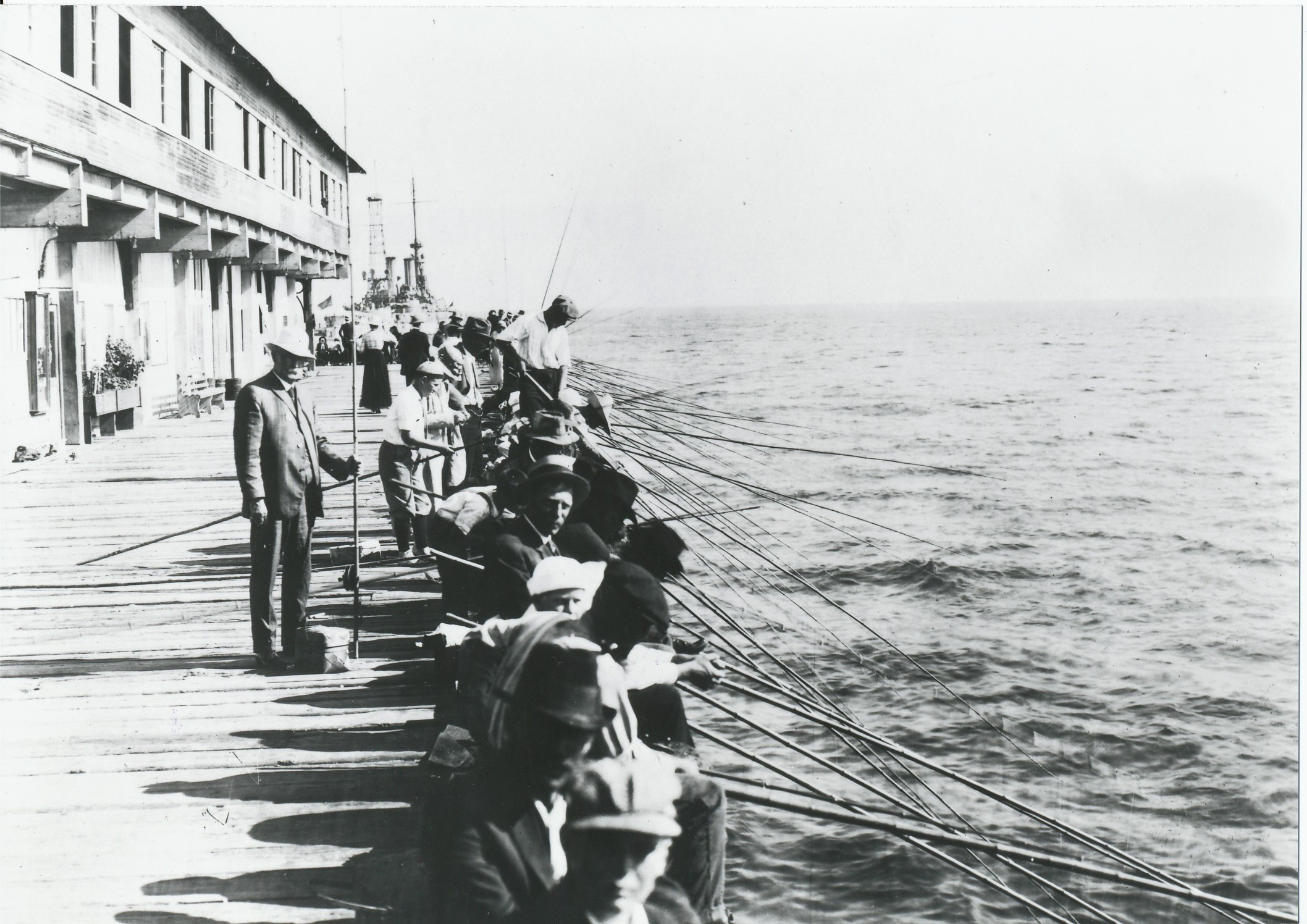
Fishing from the Pine Avenue Pier
Over the years the municipal pier was to suffer the damage that is common to all piers. In 1910 a high tide washed out 80 feet of the pier. On March 11, 1912, the newspaper reported that the “mad fury of a sixty mile gale tears out the south end of the pier,” the next day it recorded that a “gale is raging offshore, yet the pier still stands.” On May 25 the paper reported that the pier is closed due to piling damage from a storm. On September 14, 1921, a report was given that “the Pine Avenue Pier is condemned,” but in 1929 a new report stated that ground breaking for the W.L. Poterfield building marks the beginning of the end for the pier. But, the pier would survive for five more years courtesy of a new pier—the Rainbow Pier.
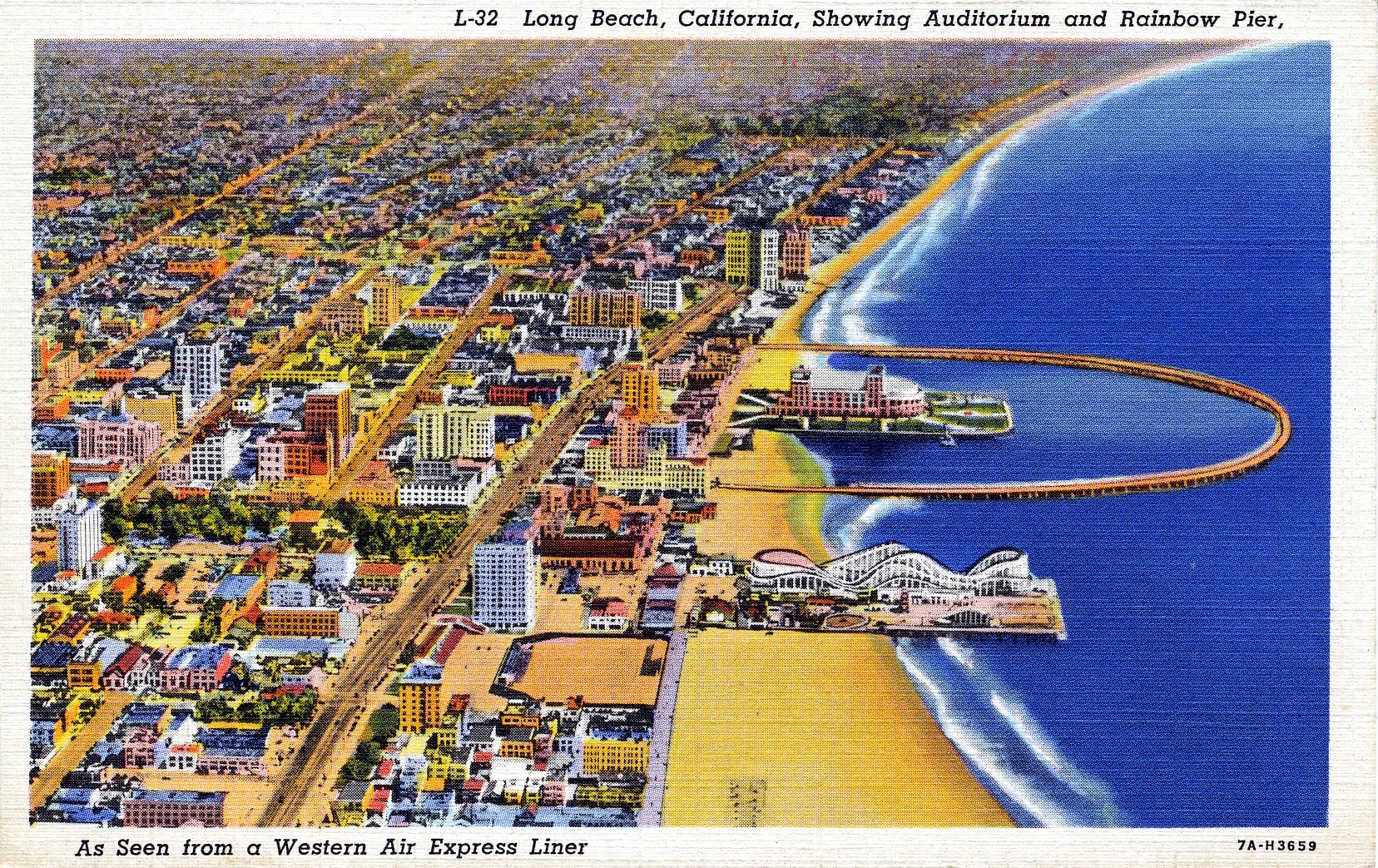
The Rainbow Pier
As the Pacific Electric tracks neared their Long Beach terminus, citizens of the seaside resort rushed preparations for the crowds and new way of life the trolleys were expected to bring. The most notable preparations included added safety precautions on the seashore for inlanders who were not accustomed to the rolling surf and city ordinances which sought to protect the dignity of Pine Avenue, the town’s main street, by making it illegal to stroll on the sidewalks either in “beach costume” or carrying fishing poles… The mention of Long Beach always had inspired a tongue-in-cheek attitude among the more sophisticated inlanders. Santa Monica made no secret of being a roaring resort, where one could enjoy the seashore with a glass of beer and revel in non-Victorian activities. Long Beach, with its strict ban on liquor and Sunday closing of most stores, was regarded as the seaside resort for the more conservative elements.
—Ride the Big Red Cars, Spencer Crump, 1970, and Long Beach Press, June 26, 1902
With the extension of the Pacific Electric Railway into the area in 1902 both tourism and the city’s population boomed (it was the nation’s fastest growing city during the decade 1900-1910). Visitors found a wide, sandy, and long beach, a pleasure pier, and soon, next to the municipal pier, the “Pike” was developed, an amusement area that stretched almost a mile from Pine Avenue to Ocean Boulevard. The “Pike” would become famous throughout southern California. Attractions included the Looff Carousel, the Walk of a Thousand Lights, and in 1907 a small roller coaster that was simply called The Roller Coaster or The Figure Eight. Eventually the “Pike” itself would gain the nickname “Walk of a Million Lights.”
By 1912 there were several plans to build new roller coasters and new amusement piers. Most of the piers were never finished but E.R. Campbell constructed one in 1915. Known first as the Campbell Pier, it was later known as the Neptune Pier and finally as the Silver Spray Pier. The pier contained a number of what today seem fairly silly attractions—Monkey Dome, Pig Slide, High Brow Pigs, Snake Farm, Hit-the-Coon, skeeball, the Silver Spray Dance Hall and the Mill Chutes roller coaster.
In 1914 the Jackrabbit Racer roller coaster replaced the earlier coaster; it was the largest roller coaster on the West Coast and second largest in America (one at Riverview Park in Chicago was larger). Then, on Memorial Day 1930 a new roller coaster, the Cyclone Racer, opened. It was the world’s longest, fastest and steepest double track roller coaster and it became the final character in the story of the Long Beach coasters. It would last for 38 years, provide an estimated 25 million rides, and finally close on September 15, 1968.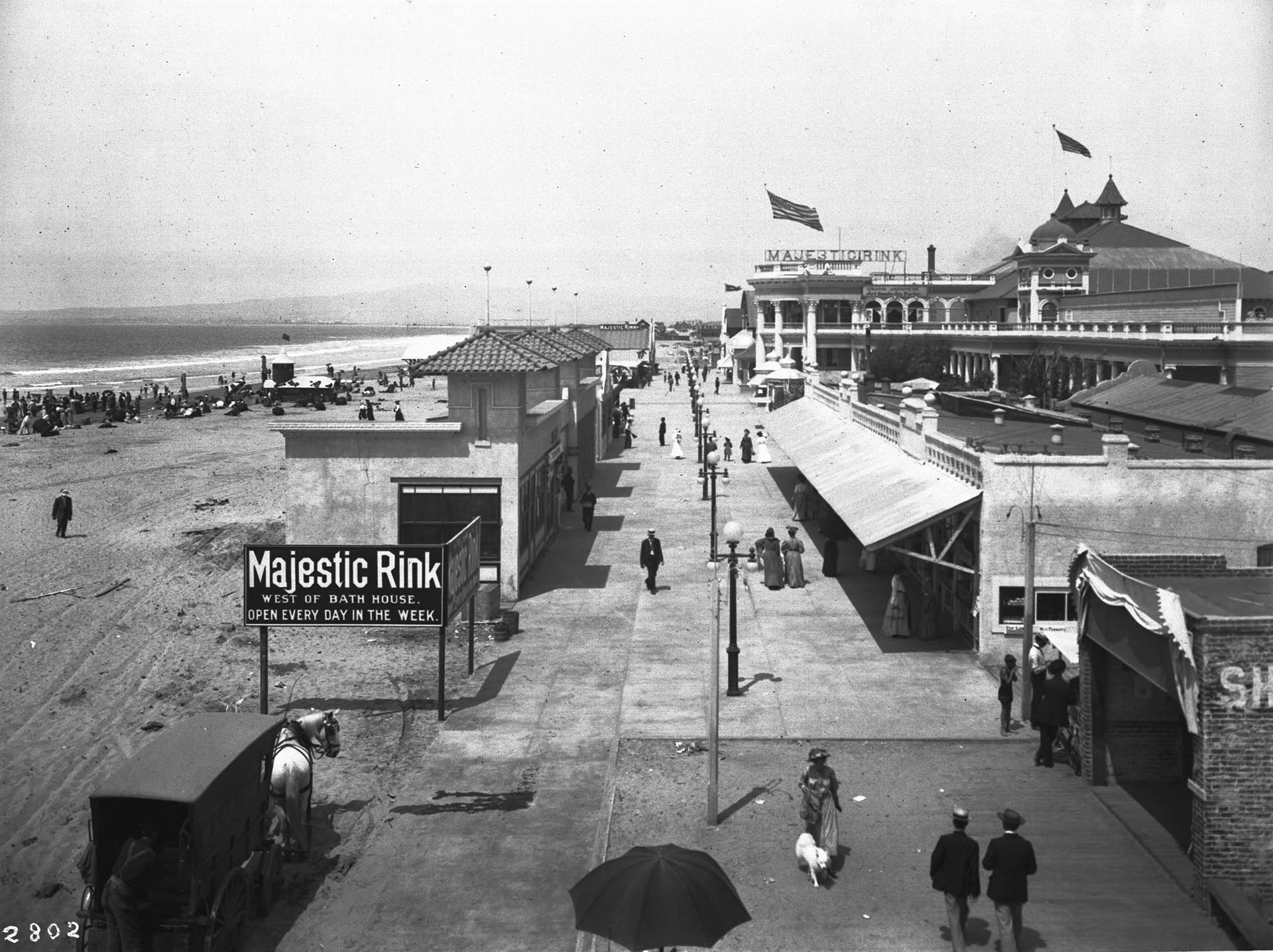
Long Beach Pike — 1907
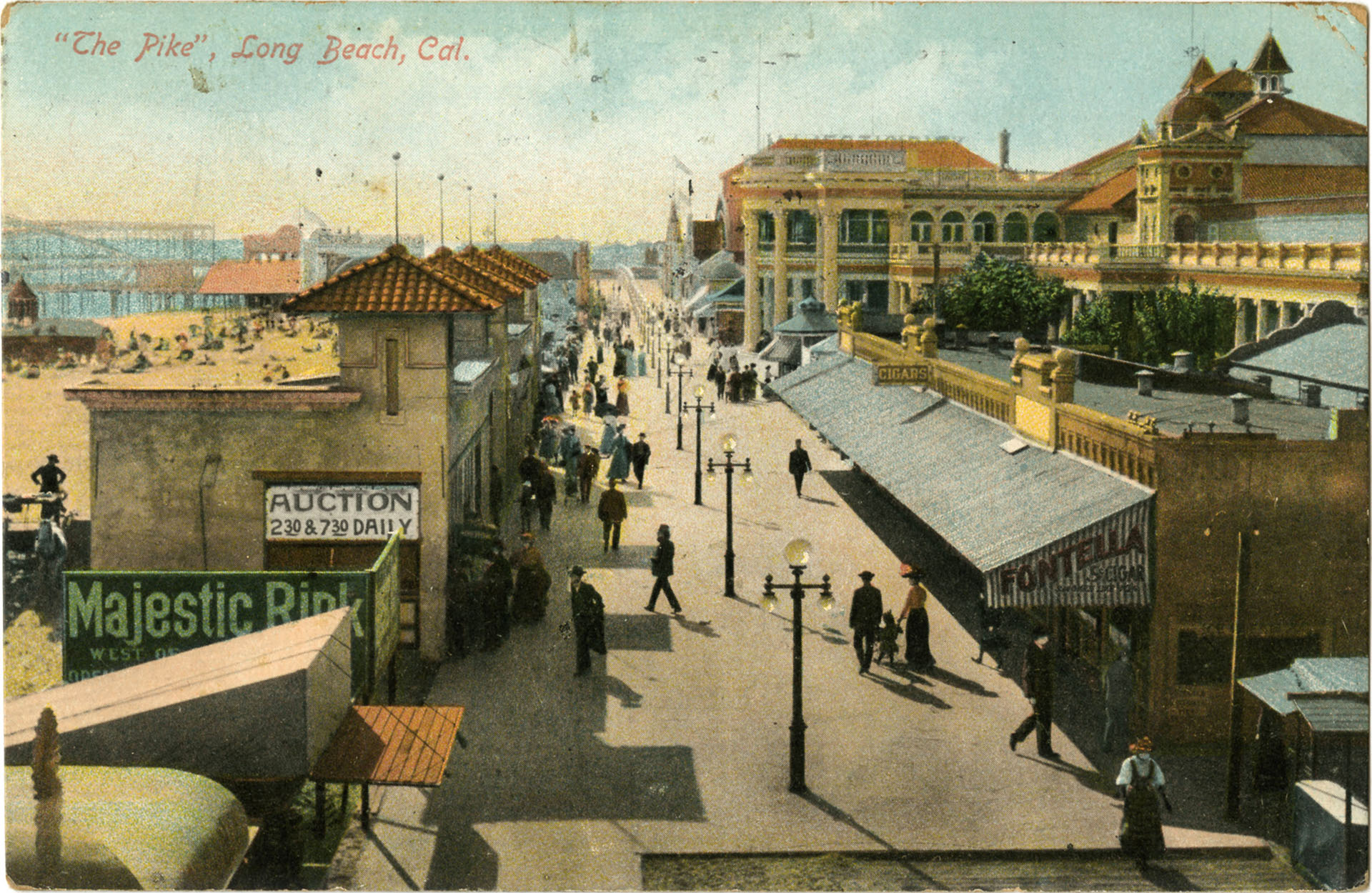
Long Beach Pike — 1910
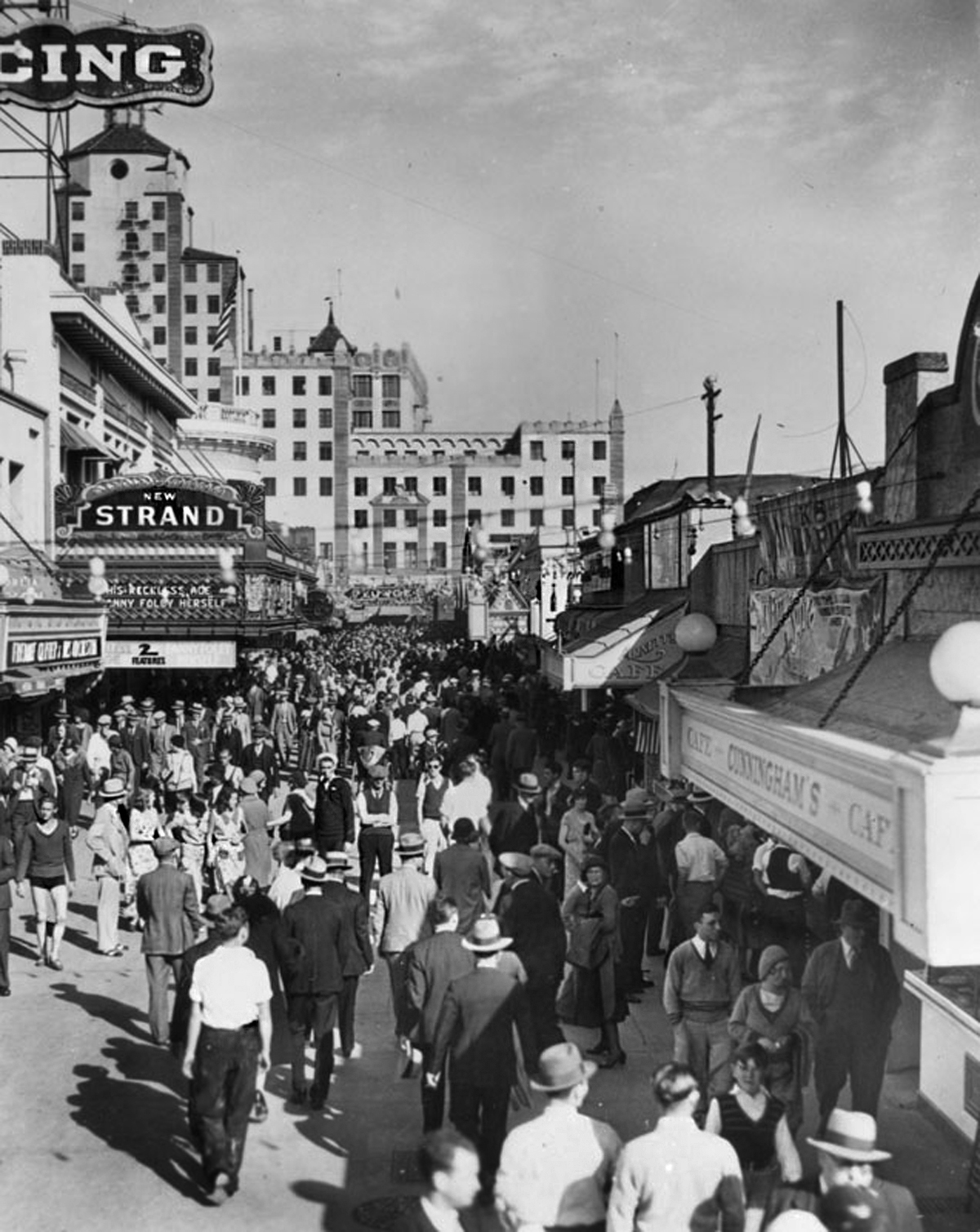
Long Beach Pike — 1930
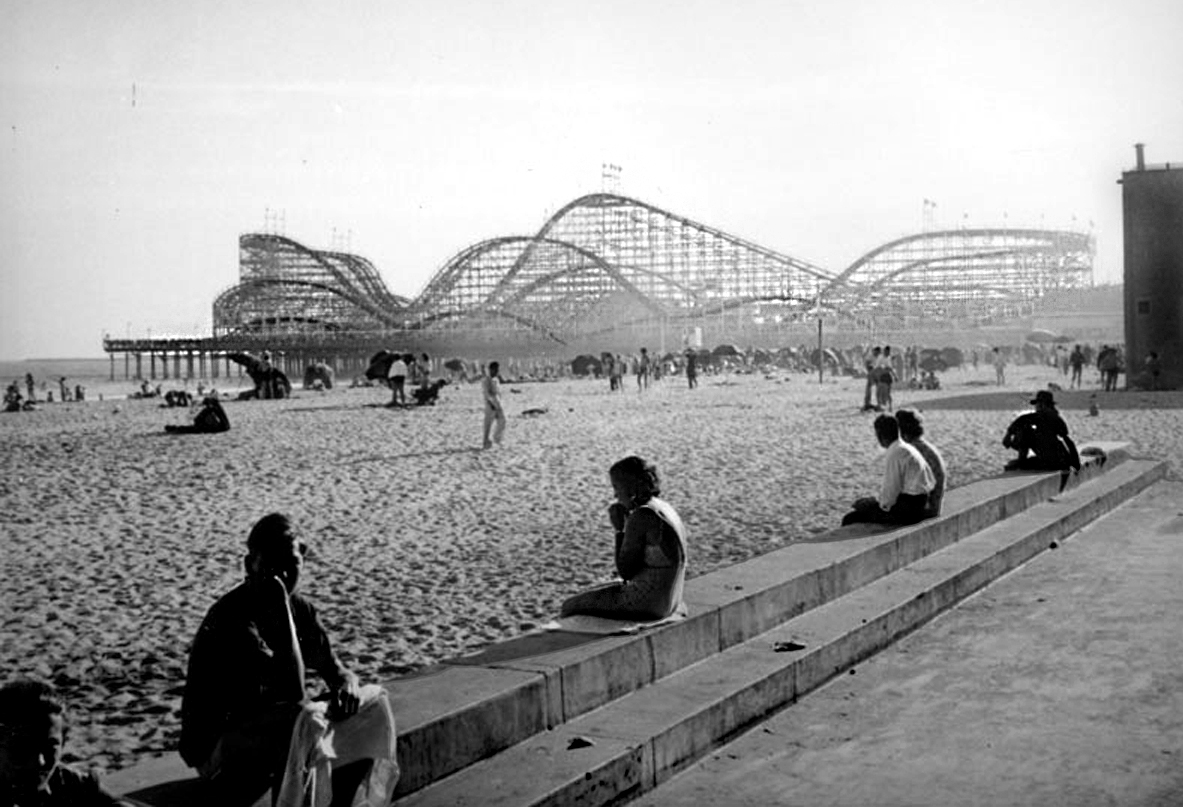
Long Beach Pike — 1937
Along the strand, at the foot of Pine Ave., the city’s main street, is the Pike, a raucous amusement area, with roller coasters, side shows, hot dog stands, and similar attractions; staid townspeople rather frown upon it as rowdy and noisy, but they overlook this for the sweet music played by tourists’ and children’s dimes and quarters as they clink at the change booths. —Workers of the Writer’s Program of the Work Projects Administrationin Southern California, Los Angeles, A Guide to the City and Its Environs, 1951
Sportfishing too was available from the pier. Ed Ries, in Pacific Coast Sportfishing,reported that several boats operated from the Pine Street Pier after about 1914 although handlines and jackpoles were more commonly used than rod and reel. Apparently large inshore runs of albacore occurred during the World War I years and handline trolling was popular, Boats that operated from the pier included the Tillikum, Moonlight, Paul G., Waterwitch, G.W., and Music. By the ‘20s, when live bait began to be carried by the boats, the albacore had decided to move offshore and few were even caught during most of the decade.
The ‘20s also saw the local introduction to barge fishing with the James McKenna(1925 to postwar) and Blue Sea(1928). The ‘30s, perhaps the heyday of barge fishing, saw several additional barges. The Shamrockand Bountywere available most of the decade while the Melrose operated for a few mid-‘30 years in Long Beach waters before moving down to San Clemente. The Samaroperated 1937-38; it would be converted to a floating machine shop in WWII.
A new chapter in the story of the downtown shoreline and piers occurred on July 25, 1931 when the Rainbow Pier was officially opened just to the south of the Pine Avenue Pier. The 3,800-foot, horseshoe-shaped pier, curved offshore from Linden Avenue to Pine Avenue, or a distance of 1,350 feet over the Pacific. It was one of the most impressive piers ever built along the coast (even if angling was only a small part of the pier’s life) and became a “must see” attraction for visitors to Long Beach. The “Pier Without Peer” had a 36-foot-wide roadway built on top of 330,000 tons of rock and supposedly 75,000 people could stand on the pier at one time. Inside the horseshoe was located the Rainbow Lagoon which quickly became one of the best places to swim in the southland, and onshore was built a Municipal Auditorium. At night, multicolored lights reflecting on the lagoon created a rainbow effect.
The Rainbow Pier had first been proposed back in 1910 by businessman S.J. Abrams as a grandiose double-decked Horseshoe Pier. It was to include a “capacious” sun parlor at the outermost point, a public bathing place, a wide space for automobiles, nine landing piers for boats, space on the lower deck for pedestrians and fishermen, and a separate concrete fishing pier extending from the southwest corner. Many of his ideas were later adopted by the city, but it took nearly twenty years and a $2.8 million bond issue in 1928 (for the pier and auditorium) before the pier was built.
In 1933 a part of the Pine Avenue Pier was resurfaced, new pilings were installed, and it became a spur which connected out from the seaward end of the Rainbow Pier. But the final day for the Pine Avenue Pier was close at hand. A storm in September of 1934 finally destroyed the pier.
Unfortunately what man can create, man and Mother Nature can also destroy. The area began to sink, apparently as a result of local oil wells, and tidal action deposited sand inside the lagoon. As a result of these two changes, the lagoon area was filled with dirt in 1955. In addition, thousands of dollars were required annually for the upkeep of the pier pilings. By the mid ‘60s it was apparent that a major rebuild would be necessary; instead, a decision was made to demolish the pier. March 20, 1966, was the last day of the Rainbow Pier and in its place came a 113-acre landfill that reached, at some points, a quarter-mile seaward.
Today, if you stand at the corner of Pine Avenue and Ocean Avenue and look west, you will see the side of the large Long Beach Convention and Entertainment Center, a pavilion-like steeple at the Shoreline Village, and weird robot-like gantry cranes (which look like something out of the Star Wars movie) off in the distance where the container ships unload. The beachfront area has been replaced by landfill, while roads lead westward to the Shoreline Aquatic Park and Village and the exciting new restaurant and shopping area adjacent to the Aquarium dubbed the “Pike” area (complete with lights that simulate a roller coaster). A freshwater lagoon, adjacent to the convention center retains, perhaps as a small tribute to the pier, the name Rainbow Lagoon Park. What you will not see is that long beach which the young lady and her sailor friends saw, the beach which was the genesis for the city’s name.
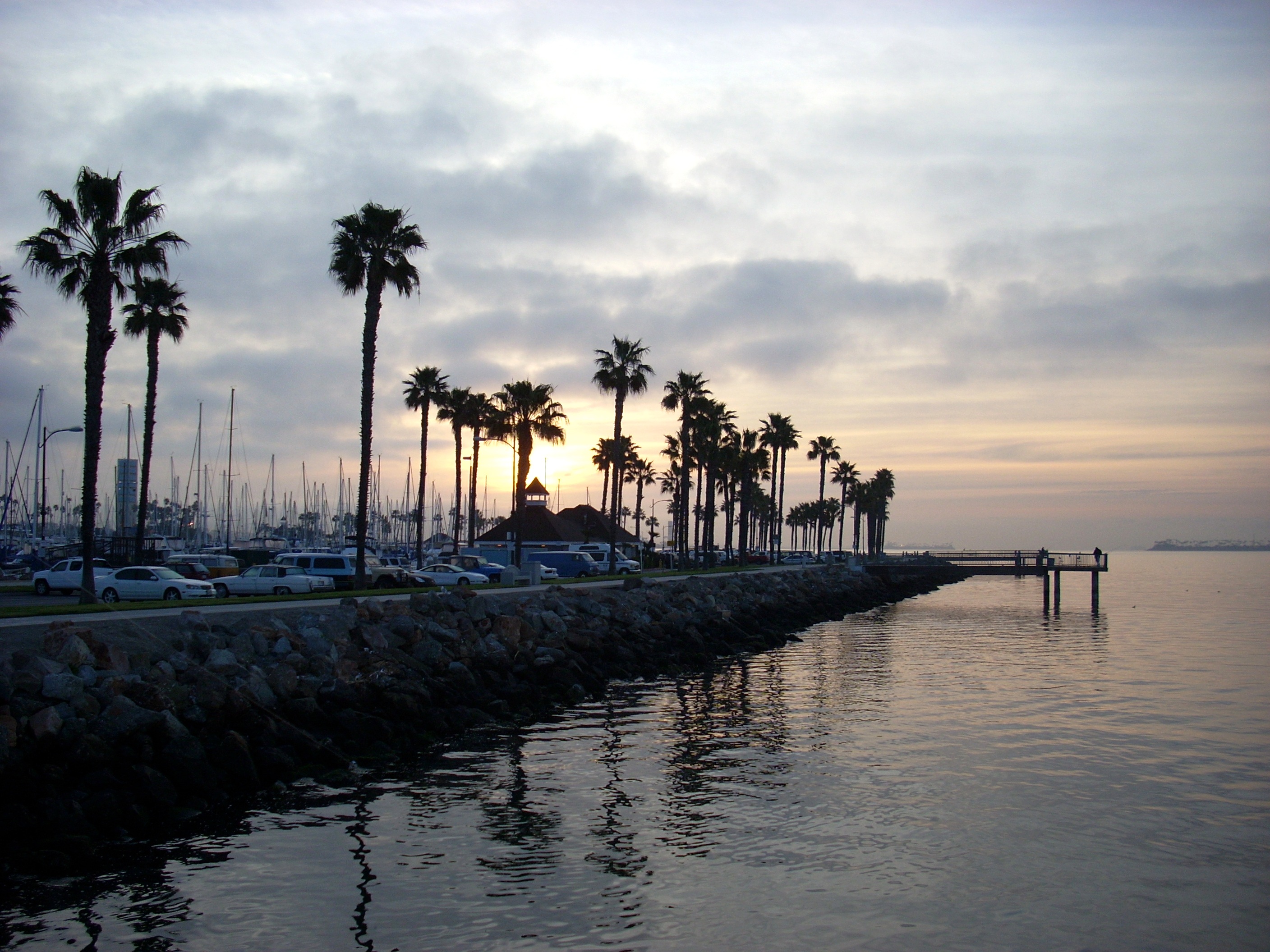
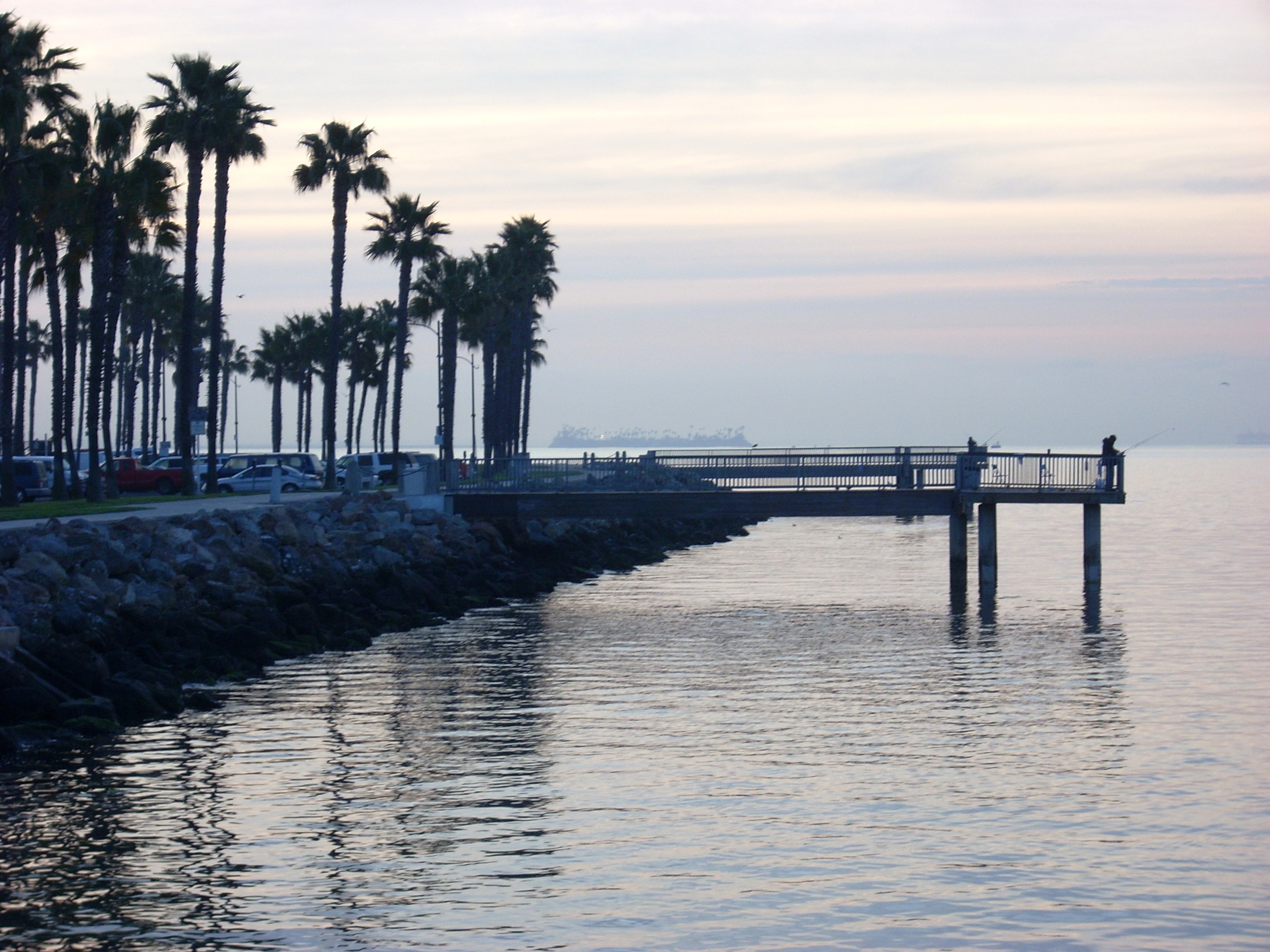
The Shoreline Aquatic Park Piers Facts
Hours: Open 24 hours a day (although the Aquatic Park area is closed at 10 P.M.).
Facilities: Extremely limited. These small piers each hold, at most, 20 people on them at a time, and that would be crowded. There are no lights, benches, fish cleaning stations, or nearby sources of food or bait. There are a few metered parking spaces near the front of each of the piers; parking is $1.00 per hour (bring quarters). There is a public restroom next to Pier #2 but it’s only open during the day.
Handicapped Facilities: Handicapped parking adjacent to most piers; piers have a wooden plank surface and railing are approximately 40 inches high.
Location: The five piers — (1) 33.756680780956465 N. Latitude, 118.18809628486633 W. Longitude; (2) 33.757153539975135 N. Latitude, 118.18937301635742 W. Longitude; (3) 33.75771549541722 N. Latitude, 118.1905210018158 W. Longitude; (4) 33.75968677030115 N. Latitude, 118.19498419761658 W. Longitude; (5) 33.76022195022798 N. Latitude, 118.19730162620544 W. Longitude.
How To Get There: From inland areas take I-710 south and follow it to the Shoreline Drive. From downtown Long Beach, take Pine Avenue south to Shoreline Drive. For the northernmost piers follow Shoreline Avenue west and follow it around the lagoon to where the street ends. For the southernmost piers, follow Shoreline Drive east to the markings for Shoreline Village, continue past the shopping complex, and follow the road out to near the end of the peninsula. You will see the various piers as you drive the road out to the end.
Management: City of Long Beach; Department of Parks and Recreation.
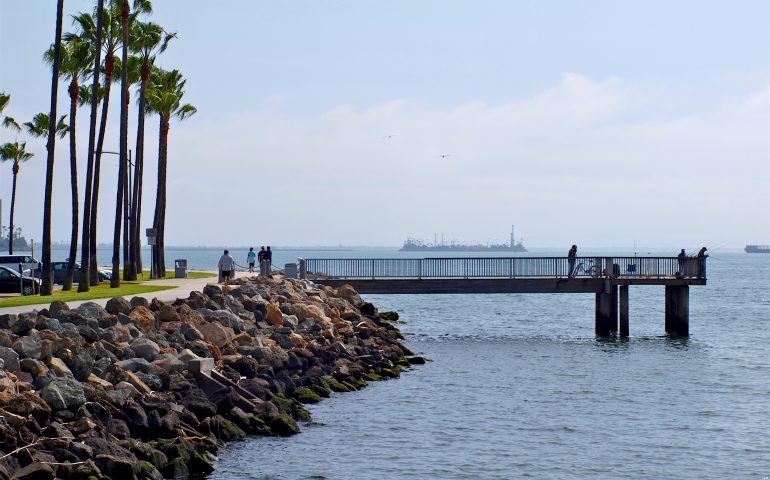
Thanks for the info! one thing though, the “mystery sculpin” you mentioned on page 1 is actually a combtooth blenny. I thought it would be hard to hook one of those, especially since they are primarily herbivores.
“There are a few metered parking spaces near the front of each of the piers; parking is $1.00 per hour (bring quarters). There is a public restroom next to Pier #2 but it’s only open during the day.”
Are there any FREE parking anywhere at all or all metered parking only?! Could someone please let us know; me and my 13 year old boys would love to check it out. Thanks in advance.